
About UsThe Numismatic Bibliomania Society is a non-profit association devoted to the study and enjoyment of numismatic literature. For more information please see our web site at coinbooks.org SubscriptionsThose wishing to become new E-Sylum subscribers (or wishing to Unsubscribe) can go to the following web page link MembershipThere is a membership application available on the web site Membership Application To join, print the application and return it with your check to the address printed on the application. Print/Digital membership is $40 to addresses in the U.S., and $60 elsewhere. A digital-only membership is available for $25. For those without web access, write to: Terry White, Treasurer AsylumFor Asylum mailing address changes and other membership questions, contact Terry at this email address: terrywhite5475@yahoo.com SubmissionsTo submit items for publication in The E-Sylum, write to the Editor at this address: whomren@gmail.com
BUY THE BOOK BEFORE THE COIN |
- WAYNE'S WORDS: THE E-SYLUM JANUARY 6, 2019
- NUMISMATIC LITERATURE AT THE 2019 NYINC
- KOLBE & FANNING SALE 151 HIGHLIGHTS
- CRAIG N. SMITH (1946-2018)
- THE 300TH ISSUE OF THE LOVE LETTER
- VIDEO: COIN COLLECTING ON A BUDGET
- COPYRIGHTED WORKS ENTERING THE PUBLIC DOMAIN
- BRITISH LIBRARY DATA SCIENCE PROJECT LAUNCHED
- FIRST INTERNATIONAL COIN DESIGNER TRAINING HELD
- NOTES FROM E-SYLUM READERS: JANUARY 6, 2019
- THE COLUMBIA & WASHINGTON MEDAL
- ORIENTAL NUMISMATICS AT THE ESSEX INSTITUTE
- VOCABULARY TERM: CANNELURING MACHINE
- FERDINAND MARIE TRIFET (1848-1899)
- ALAN ROY AND CANADIAN NUMISMATIC LITERATURE
- THE JANIS IAN COLLECTION
- PAUL NUGGET JOINS DAVID LAWRENCE RARE COINS
- QUIZ: NUMISMATICS AND SPORTS
- BURGLARY AT LEU NUMISMATIK
- BONHAMS OFFERS CLARK GRUBER TERRITORIAL GOLD
- DAVISSONS AUCTION 38 CLOSES FEBRUARY 27TH 2019
- RAY CZAHOR PHILIPPINES SALE SELECTIONS
- NUMISMATIC NUGGETS: JANUARY 6, 2019
- JANUARY 2019 MEDAL SELECTIONS FROM NUMISMAGRAM
- THE COINAGE OF HERACLIUS
- HUDSON'S BAY COMPANY MADE-BEAVER TOKENS
- GOLD DUST AS CURRENCY IN ALASKA
- ANTHONY PAQUET’S MEDALETS
- ROYAL HUMANE SOCIETY GOLD MEDAL SOLD
- 500-EURO BANKNOTES: THE LAST PRINT RUNS
- THE BOND THAT STILL PAYS, 280 YEARS LATER
- LOOSE CHANGE: JANUARY 6, 2019
Click here to access the complete archive a
Click here to unsubscribe (scroll down)
To comment or submit articles, reply to whomren@gmail.com
Content presented in The E-Sylum is not necessarily researched or independently fact-checked, and views expressed do not necessarily represent those of the Numismatic Bibliomania Society.
WAYNE'S WORDS: THE E-SYLUM JANUARY 6, 2019
 New subscribers this week include:
Dave Chandler of Lancaster, California;
Paul Nugget, courtesy of John Brush;
Thomas Contis, and
Phillip Freshour.
Welcome aboard! We now have 5,814 subscribers.
New subscribers this week include:
Dave Chandler of Lancaster, California;
Paul Nugget, courtesy of John Brush;
Thomas Contis, and
Phillip Freshour.
Welcome aboard! We now have 5,814 subscribers.
Thank you for reading The E-Sylum. If you enjoy it, please send me the email addresses of friends you think may enjoy it as well and I'll send them a subscription (but let me know if they are located in the European Union). Contact me at whomren@gmail.com anytime regarding your subscription, or questions, comments or suggestions about our content.
This week we open with numismatic literature at the New York International, highlights from the upcoming Kolbe & Fanning numismatic literature sale, and the loss of bibliophile Craig Smith.
Other topics this week include the Love Letter, the British Library's data science project, coin designer training, the Columbia & Washington medal, the Janice Ian collection, numismatics and sports, Clark Gruber territorial gold, Made Beaver tokens, gold dust as currency, and the bond that still pays 280 years later.
To learn more about Benjamin Collins's large cents, John Robinson's oriental coins, coin collecting on a budget, canneluring machines, the testoon of Mary Stuart, the 1859 Philippines Paris Mint 80 Reales pattern, Elder's Roald Amundsen token, Dennis Wegley, colorized silver eagles and Cheechako Money, read on. Have a great week, everyone!
Wayne Homren
Editor, The E-Sylum
NUMISMATIC LITERATURE AT THE 2019 NYINC
The 47th New York International Numismatic Convention (NYINC) will be held January 4-13, 2019 at the Grand Hyatt Hotel on East 42nd Street. I won't be able to attend this year, expect many of our readers will. Numismatic literature and publishing will be well represented. -Editor
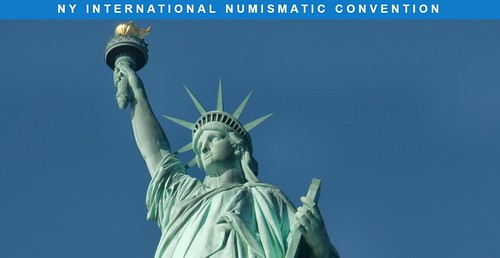
Charlie Davis of Charles Davis Numismatic Literature writes:
I will have a literature booth in the lobby area just outside the bourse entry.
David Fanning of Kolbe-Fanning Numismatic Booksellers writes:
Kolbe & Fanning are not conducting an auction at the show this year, though we are holding one a couple weeks later on January 26. However, both George and I will be attending the show and will be available to chat with clients during the bourse days of January 10-12, and look forward to seeing many friends there.
Tables will be manned by the American Numismatic Society and publishers Coin World, London's Token Publishing and Germany's CoinsWeekly.
Also be on the lookout for E-Sylum supporters Steve Album Rare Coins, Classical Numismatic Group, Dix Noonan Webb, Heritage Auctions, Shanna Schmidt, Daniel Frank Sedwick and Stack's Bowers-Ponterio. Thanks!
And don't forget to visit with regular E-Sylum contributors Paul Bosco, Andy Lustig, Tony Terranova, and Jeffrey Zarit. -Editor
For more information on the show, see:
http://www.nyinc.info/

KOLBE & FANNING SALE 151 HIGHLIGHTS
Here are some highlights of the upcoming Kolbe & Fanning numismatic literature sale. -Editor
Kolbe & Fanning Numismatic Booksellers are conducting our 151st auction of numismatic literature on Saturday, January 26, 2019. The sale includes material on ancient, foreign and U.S. numismatics, with the 500 lots offering a wide variety of books for the collector’s consideration.
Some highlights include:
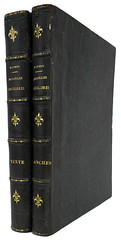
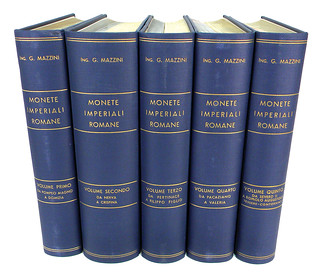
Lots 43 and 145
Lot 43: an attractive copy, bound in two volumes, of Cohen’s classic 1857 work on Roman Republican coins
Lot 145: a fine set of Mazzini's five-volume Monete Imperiali Romane
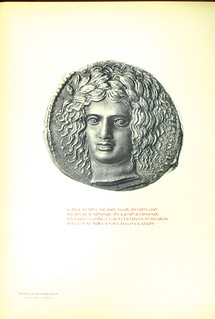
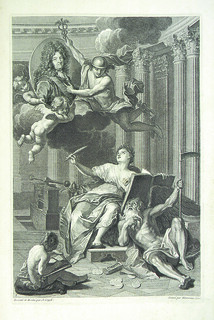
Lots 182 and 233
Lot 182: an original set of Giulio Emanuele Rizzo's extraordinary Monete Greche della Sicilia
Lot 233: the majestic 1702 folio edition of Médailles sur les Principaux Événements du Règne de Louis le Grand, the foundational work on the medals of Louis XIV
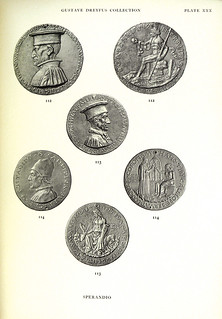
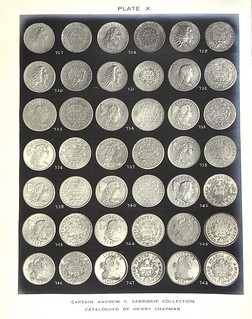
Lots 277 and 377
Lot 277: George Francis Hill's massive 1931 catalogue of the Gustave Dreyfus collection of Renaissance medals
Lot 377: Howard R. Newcomb's copy of Henry Chapman's 1909 catalogue of the Andrew C. Zabriskie collection, with photographic plates and with Newcomb's invoices from the sale laid in
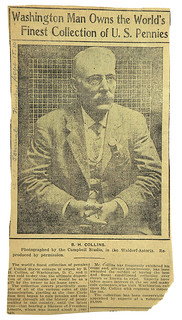
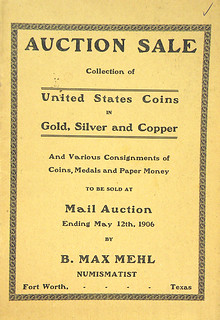
Lots 386 and 443
Lot 386: Benjamin Collins's original handwritten manuscript inventory of his outstanding collection of United States large cents, with additional notes by Collins on its disposition and further materials on the collection by John W. Adams and Del Bland
Lot 443: a complete set of the auction catalogues of B. Max Mehl.
Bidders may participate in the sale online or through more traditional means. Bids may be placed via post, email, fax or phone, as well as online. Kolbe & Fanning use Auction Mobility as our third-party online bidding platform. Auction Mobility is an app-based platform allowing users the ability to participate in the sale through phones, tablets and computers. To register for the online sale, bidders must go to bid.numislit.com and sign up. Once you have set up an account, you may browse lots, place advance bids, or participate in the live sale online. Those wishing to participate on their devices can download the Kolbe & Fanning app through the Apple or Google Play Store.
The printed catalogue of Sale 151 will be mailed this week to active customers. A PDF of the printed catalogue has been posted to our main website at numislit.com for those who prefer that format. Bids placed via post, email, fax or phone must be received by January 25, the day before the sale, in order for them to be processed. Advance absentee bids may also be placed online at bid.numislit.com; live internet bidding will be available during the sale itself through the same platform.
Kolbe & Fanning Numismatic Booksellers LLC is a licensed and bonded auction firm in the State of Ohio. For more information, please see the Kolbe & Fanning website at numislit.com or email David Fanning at df@numislit.com. To register for the sale, go to bid.numislit.com. We look forward to your participation.
To read the earlier E-Sylum article, see:
Kolbe & Fanning SALE 151 JANUARY 26, 2018
(https://www.coinbooks.org/v21/esylum_v21n51a03.html)
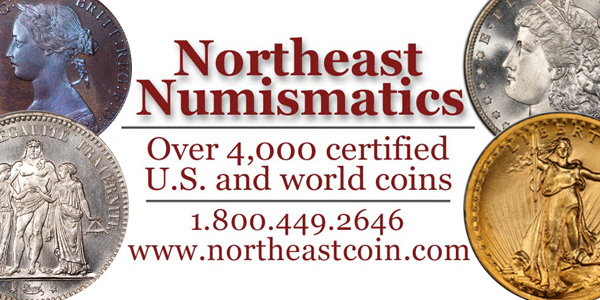
CRAIG N. SMITH (1946-2018)
Numismatic literature dealer and NBS co-founder George Frederick Kolbe submitted this remembrance of collector Craig Smith. Thank you! -Editor
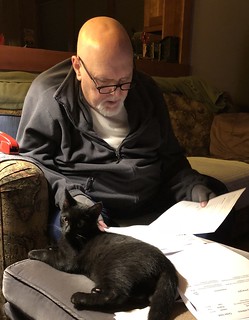 Craig and I became friends in the second half of the 1990s. His collecting interests were wide-ranging and he loved to learn everything about the items he acquired, whether they be early American maps and atlases, pinball machines, cars, vintage catalin clocks and radios, coins, or numismatic literature. We both grew up in Pasadena, California, though I was several years older, and for many years we engaged in frequent and often extended telephone conversations. We were simpatico.
Craig and I became friends in the second half of the 1990s. His collecting interests were wide-ranging and he loved to learn everything about the items he acquired, whether they be early American maps and atlases, pinball machines, cars, vintage catalin clocks and radios, coins, or numismatic literature. We both grew up in Pasadena, California, though I was several years older, and for many years we engaged in frequent and often extended telephone conversations. We were simpatico.
Craig's spouse, Ruanne (Ron) Smith has kindly supplied additional commentary on Craig's interests: "he collected guns, knives, juke boxes, slots, trade stimulators, pocket watches and early gaming dice, too. The thing is, once he got interested, he bought every book he could find about the subject. So, he not only has a numismatic library, he has a library of many varied subjects. He was particularly interested in the history of the United States, including railroad expansion and creation of the intercontinental railway, California history, the Gold Rush era and has many books in these areas as well."
 I met Craig and Ron Smith in early 2005. Upon landing in Seattle, I rented a car and drove north to the ferry terminal, landing shortly thereafter on Whidbey Island. From there I drove to the City of Freeland and to the Smiths' beautiful waterfront home. Adjacent to it was a large structure devoted to various collecting interests. Outside their home, their delightful dog Mel—perpetually holding two tennis balls in her mouth — was ever ready for a game of fetch. Inside was, of course, the library; many of Craig and Ruanne's smaller collectables adorned the living areas.
I met Craig and Ron Smith in early 2005. Upon landing in Seattle, I rented a car and drove north to the ferry terminal, landing shortly thereafter on Whidbey Island. From there I drove to the City of Freeland and to the Smiths' beautiful waterfront home. Adjacent to it was a large structure devoted to various collecting interests. Outside their home, their delightful dog Mel—perpetually holding two tennis balls in her mouth — was ever ready for a game of fetch. Inside was, of course, the library; many of Craig and Ruanne's smaller collectables adorned the living areas.
In less than a decade, the Smiths assembled a select but outstanding numismatic library, reflective of Craig's love of history and interest in American coins, and enhanced by Ron's interest in ancient coins and their shared appreciation of the book beautiful. Craig and Ron rarely traveled and most of their key acquisitions were made with little fanfare or notoriety. Only when the library was sold via public and mail auction in a June 2005 Kolbe sale, did their accomplishment become widely known.
Craig forged a friendship with Eric Newman and they shared information on pioneer gold coins, particularly those of dubious origin. His important collection of coins on the topic was sold anonymously in a June 2000 Bowers and Merena auction sale. Craig's United States coins were sold in a 2003 B & M sale.
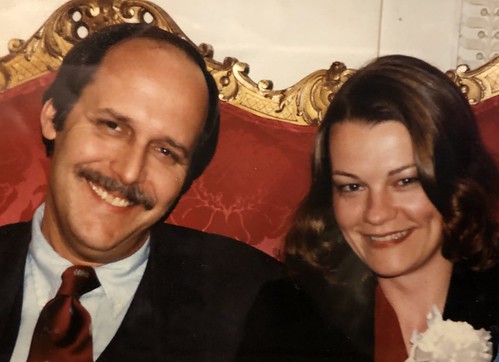
Craig and Ron Smith in the early 1980s
The world is a poorer place without Craig Smith. His gusto for collecting and his thirst for information, if not publicly known, was still a force in enhancing our knowledge about all sorts of things. He will be sorely missed.
THE 300TH ISSUE OF THE LOVE LETTER
The Love Token Society has just celebrated the 300th issue of its official publication, the Love Letter. Congratulations! -Editor
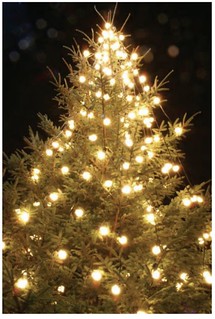 Three hundred lights on a Christmas tree. Three hundred
snowflakes viewed from my window. Three hundred stars twinkling
in the night sky. Three hundred, what a glorious number that can
encompass so many things in the magic of this holiday season. Yet
best of all is the three hundredth issue of the Love Letter arriving just
in time for the holidays. In its infancy, this member correspondence
was a scant half to whole page and arrived monthly. Through the
years it evolved and grew to what it is today. This three hundredth
issue is the culmination of forty six years since the Love Token Society
was founded. In just four short years LTS will be celebrating its fifty
year anniversary. Imagine if we could grow our membership to three
hundred in time for the anniversary.
Three hundred lights on a Christmas tree. Three hundred
snowflakes viewed from my window. Three hundred stars twinkling
in the night sky. Three hundred, what a glorious number that can
encompass so many things in the magic of this holiday season. Yet
best of all is the three hundredth issue of the Love Letter arriving just
in time for the holidays. In its infancy, this member correspondence
was a scant half to whole page and arrived monthly. Through the
years it evolved and grew to what it is today. This three hundredth
issue is the culmination of forty six years since the Love Token Society
was founded. In just four short years LTS will be celebrating its fifty
year anniversary. Imagine if we could grow our membership to three
hundred in time for the anniversary.
For more information on the Love Token Society, see:
http://lovetokensociety.com/

VIDEO: COIN COLLECTING ON A BUDGET
The latest addition to the Newman Numismatic Portal is a new video, Coin Collecting on a Budget. Project Coordinator Len Augsburger provided the following report. -Editor
 The Newman Numismatic Portal announces the release of a new video from Morehead State (KY) senior Lianna Spurrier, Coin Collecting on a Budget. Lianna explores a number of approaches, from roll hunting to bargain bins to Coinstar machines, demonstrating meaningful collections that can be formed in various, inexpensive ways. The video will appeal to young numismatists, and even grizzled, old veterans may find themselves inspired to get back to the basics! Lianna will continue working on a series of videos, on behalf of Newman Portal, aimed at young numismatists.
The Newman Numismatic Portal announces the release of a new video from Morehead State (KY) senior Lianna Spurrier, Coin Collecting on a Budget. Lianna explores a number of approaches, from roll hunting to bargain bins to Coinstar machines, demonstrating meaningful collections that can be formed in various, inexpensive ways. The video will appeal to young numismatists, and even grizzled, old veterans may find themselves inspired to get back to the basics! Lianna will continue working on a series of videos, on behalf of Newman Portal, aimed at young numismatists.
Link to Coin Collecting on Budget on Newman Portal
https://nnp.wustl.edu/library/multimediadetail/529486?FromArchives=True
COPYRIGHTED WORKS ENTERING THE PUBLIC DOMAIN
Happy New Year! Or shall we say, Happy Entering-the-Public-Domain Year? This article summarizes the history of copyrights in the U.S., and notes that all music, literature and films released in 1923 are now in the public domain and freely available for use. -Editor
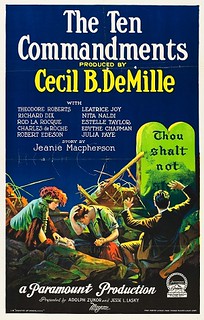 For the first time in more than two decades, an entire year's worth of copyrighted works will enter the public domain.
For the first time in more than two decades, an entire year's worth of copyrighted works will enter the public domain.
All music, literature and films released in 1923 will be freely available for you to adapt, remix and reuse as you see fit starting Jan. 1.
They include Cecil B. DeMille's "The Ten Commandments" and Robert Frost's "Stopping by Woods on a Snowy Evening," along with works from Aldous Huxley and Edith Wharton.
You can also expect Google Books to offer the full text of books from that period and the Internet Archive to add 1923 works to its online library.
Over the next couple of decades, you're going to see films like "Gone With the Wind," "The Wizard of Oz," "Casablanca" and "Citizen Kane," along with comic book characters like Batman and Superman, entering the public domain, Zerner pointed out.
"We are now living in a new world starting Jan 1. The clock is ticking," he said.
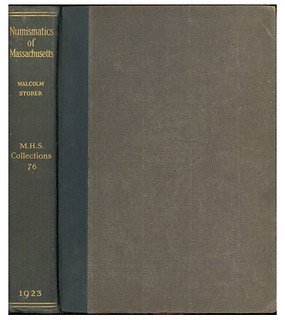 So what does this have to do with numismatics? Well, the Newman Numismatic Portal can only provide full access to documents in the public domain, or those for which the copyright owners have explicitly permitted such access. Now all numismatic literature published in 1923 (books, periodicals, auction catalogs etc.) is fair game for hosting on NNP with no agreement required - for example, Malcolm Sorer's Numismatics of Massachusetts, published by the Massachusetts Historical Society.
So what does this have to do with numismatics? Well, the Newman Numismatic Portal can only provide full access to documents in the public domain, or those for which the copyright owners have explicitly permitted such access. Now all numismatic literature published in 1923 (books, periodicals, auction catalogs etc.) is fair game for hosting on NNP with no agreement required - for example, Malcolm Sorer's Numismatics of Massachusetts, published by the Massachusetts Historical Society.
Going forward, the bar will advance each year with 1924 works becoming available in 2020, and so on). -Editor
To read the complete article, see:
Copyrighted works are entering the public domain for the first time in 20 years
(https://www.marketplace.org/2018/12/28/business/public-domain-day-2019)

BRITISH LIBRARY DATA SCIENCE PROJECT LAUNCHED
Digitization is only the beginning. Making books, periodicals and other research materials available online is the first step, allowing humans to find and consume individual works. But once digitized, information is freed from the pages and enters a whole new realm where it can be analyzed, enhanced, connected and studied by computers, data scientists and other scientists and researchers of all stripes. The British Library has initiated a project that takes this next step into computer-powered information analysis. Here's an excerpt from a December 19, 2018 press release. -Editor
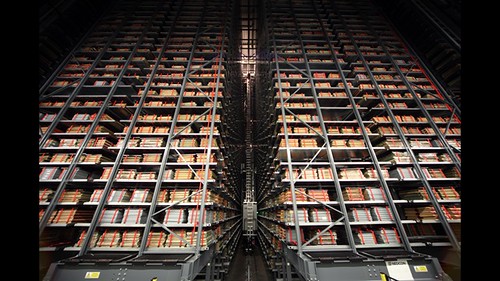
The Alan Turing Institute and the British Library, together with researchers from a range of universities, have been awarded £9.2 million from the UKRI's Strategic Priorities Fund for a major new project. ‘Living with Machines', which will take place over five years, is set to be one of the biggest and most ambitious humanities and science research initiatives ever to launch in the UK.
'Living with Machines' will see data scientists working with curators, historians, geographers and computational linguists with the goal to devise new methods in data science and artificial intelligence that can be applied to historical resources, producing tools and software to analyse digitised collections at scale for the first time.
In recognition of the significant changes currently underway in technology, notably in artificial intelligence, the project will use the century following the first Industrial Revolution, and the changes brought about by the advance of technology across all aspects of society during this period as its focus point.
Initial research plans involve scientists from The Alan Turing Institute collaborating with curators and researchers to build new software to analyse data drawn initially from millions of pages of out-of-copyright newspaper collections from within the archive in the British Library's National Newspaper Building, and from other digitised historical collections, most notably government collected data, such as the census and registration of births, marriages and deaths. The resulting new research methods will allow computational linguists and historians to track societal and cultural change in new ways during this transformative period in British history. Crucially, these new research methods will place the lives of ordinary people centre-stage, rather than privileging the perspectives of decision-makers and public commentators.
‘Living with Machines' will take a radical approach to collaboration, breaking down barriers between academic traditions, bringing together data scientists and software engineers from The Alan Turing Institute and curators from the British Library as well as computational linguists, digital humanities scholars and historians from universities including Exeter, University of East Anglia, Cambridge and Queen Mary University of London.
The research methodologies and tools developed as a result of the project will transform how researchers can access and understand digitised historic collections in the future.
Adrian Smith, Director of The Alan Turing Institute, commented:
"Data science and artificial intelligence have the potential to supercharge the science and humanities. We can analyse vast amounts of data at a huge scale and uncover new insights and questions, as in this timely project with the British Library which will apply data-driven techniques to examine the human, social and cultural impact of the first industrial revolution. It is thrilling to bring together this diverse range of experts to work on this important research problem and deliver tools and techniques which will benefit scholars for generations to come."
What does this mean for numismatic researchers? Well, it brings hope that someday these modern techniques will come to the digital stores of numismatic data being amassed by the Newman Numismatic Portal and private firms alike. In the short term, it could mean that new information on British numismatics could be gleaned from the British Library's vast digital stores. -Editor
To read the complete article, see:
Living with Machines: The Alan Turing Institute and the British Library awarded £9.2 million for a major new project set to revolutionise research
(https://www.bl.uk/press-releases/2018/december/living-with-machines)
For more information on the Alan Turing Institute, see:
https://www.turing.ac.uk/
To visit the Newman Numismatic Portal, see:
https://nnp.wustl.edu/
FIRST INTERNATIONAL COIN DESIGNER TRAINING HELD
Lou Golino published a nice article on Coin Update January 3, 2019 about the recently concluded First International Coin Designer Training program. Held in Shanghai, international coin and medal designer Joel Iskowitz, formerly of the U.S. Mint's Artistic Infusion Program, was among several veteran coin designers and medallic artists from around the world who shared their expertise. Here's an excerpt, but see the complete article online for more information and pictures. -Editor
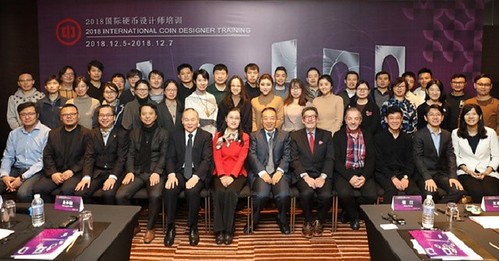
2018 International Coin Designer Training at Shanghai Mint participants
In early December the Chinese Mint held the first International Coin Designer Training program at its Shanghai branch mint, which brought together several prominent coin designers from Europe, the U.S., and China. These experienced coin designers and medallic artists shared their wealth of experience with artists and designers from China during several days of presentations and workshops.
Joel was invited to be one of the program instructors by Ms. Tina Deng of the Shanghai Mint. He is no stranger to China, having previously been there 25 years ago on a U.S. Air Force Art Program assignment.

2018 International Coin Designer Training instructors Erkki Vainio, Joel Iskowitz (with glasses), and Chinese coin designers.
Reflecting on the recent program, Joel said:
I have always believed that art is a universal language which transcends cultural and physical barriers and even time itself. As a designer of coins and medals, I have witnessed their powerful role as ambassadors of good will which connect humankind in marvelous ways. Envoys of our collective human story, they are miniature in physical size yet epic in content. Coins and medals are the nexus of history, art, and beauty.
He added:
It is my hope and belief that this first successful International Coin Designer Training inaugurates and inspires a new frontier of dedicated collaboration, a golden era of beautiful coins and medals that combine the best of our cultures and talents to add to the beauty and harmony of our world.
Joel noted that the artist identified in the article's photo as Zu Xiuai, is actually an unidentified artist who was a member of Joel's design team. Zu Xiuai is a lead designer/sculptor employee of the Shanghai Mint. He is second from the left in the below photo, next to Joel. -Editor

To read the complete article, see:
First International Coin Designer Training program held in Shanghai
(http://news.coinupdate.com/first-international-coin-designer-training-program-held-in-shanghai/)

NOTES FROM E-SYLUM READERS: JANUARY 6, 2019
More on the Clad Dime "Minus Its Cladding"
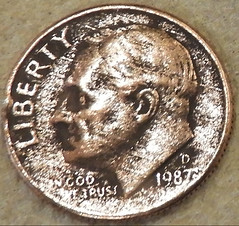

Paul Schultz writes:
I have seen a lot of corroded surfaces in my career, and the texture of the surface of that 1987 dime looks exactly like it was soaked in an acid or another corrosive solution (such as salty water, etc). Recall the old days of acid etching a dateless buffalo nickel, in which the flat date area could be read after etching, illustrating that etching a struck surface can retain or even enhance the original surface topography. An etched dime would be lighter due to material loss, rough, darkened, and still show the original image.
This coin could have been intentionally etched, or simply lost for a while in a street side snow bank where a lot of salt had been put on the road. If in doubt, look for pitting and darkness on the reeded edge that looks like the faces. The horizontal raised ridges are indicative of the rolling direction used in the manufacture of the original sheet/strip of clad metal. When rolled sheet or strip is etched, often intentionally for metallurgical microexamination, the rolling direction becomes obvious. It is due to metal flow, roll striations, crystal deformation, and slight differences in applied pressure on the sheet during the rolling process.
My first thought was post-Mint environmental damage. The lighter weight is consistent with both corrosion and the lack-of-cladding hypothesis. Having it weighed and getting better photos showing the true colors would help. But only examination by a specialist in errors familiar with lack-of-cladding errors could render an expert opinion. And as it happens, error coin expert and E-Sylum supporter Fred Weinberg weighs in as well. -Editor
Fred Weinberg writes:
The coin is not an error of any type - it's been buried in the ground for some time, or otherwise has been ‘environmentally damaged' on the surfaces, due to where it's been in the past. It's not a clad error - and it didn't leave the US Mint looking like that...
Thanks, everyone. -Editor
To read the earlier E-Sylum article, see:
NOTES FROM E-SYLUM READERS: DECEMBER 30, 2018 : Query: A Clad Dime Minus Its Cladding?
(https://www.coinbooks.org/v21/esylum_v21n52a11.html)
More on the 2 1/2 Coin Concept
Pete Smith writes:
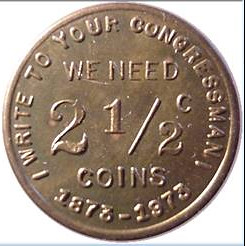 Len Augsburger inquired about a token that states "The U. S. Needs a 2 1/2 C Coin." This coin is listed on the Newman Portal on page 14 of my book "Tokens and Medals of American Numismatists". I have examples in aluminum and brass.
Len Augsburger inquired about a token that states "The U. S. Needs a 2 1/2 C Coin." This coin is listed on the Newman Portal on page 14 of my book "Tokens and Medals of American Numismatists". I have examples in aluminum and brass.
When a Spanish 1 Real coin was worth 12.5 cents, there was a need for a 2.5 cent coin to convert the Spanish coin into U. S. coins. I am not aware that the Congress ever seriously considered a coin of that denomination.
There are thousands of brass tokens that are worth 2 1/2 cents in trade. This might suggest the need for a 2 1/2 cent coin. In practical usage, a business might offer something at the price of two for a nickel. The customer could take one and receive the token in change. The token kept the patron in the bar for his second drink rather than going across the street for his second drink.
I have done a bit of a search of relevant numismatic literature. I have not found any discussion of Boosel's attempt to promote 2.5 cent coinage.
Thanks. Sales tax payments could be another potential reason. Initially, many of these state taxes were denominated in mills, or tenths of a cent. That extra half-cent could pay (or be received in change for) a sales tax of 5 mills. But with different rates across the states, it would be hard to justify a single national coin denomination other than the economically nonviable one mill.
It's true that there are quite a few "half-nickel" good-for tokens, and that's a more likely explanation. But hopefully someday someone will turn up an article/letter/flyer or other material with Boosel's own words describing his thinking. If he took his own advice and wrote to his Congressman, then perhaps a letter exists somewhere in the National Archives. -Editor
To read the earlier E-Sylum article, see:
QUERY: BOOSEL'S 2 1/2 CENT COIN CONCEPT
(https://www.coinbooks.org/v21/esylum_v21n52a08.html)
Jeremy Cheek to Speak at NYINC BNS Meeting
Regarding the British Numismatic Society meeting at NYINC,
Peter Preston-Morley writes:
The meeting will take place in the Uris Room at the Grand Hyatt Hotel on E 42nd Street, on Saturday January 12th, at 4 PM.
 Our speaker is the London-based numismatist Jeremy Cheek, the honorary numismatic consultant to the British royal collection housed in Windsor Castle, and author of the new
Spink title Monarchy, Money & Medals. This is a rare opportunity outside the UK to not only learn about the background to the collection in its current form, but also to see images of some spectacular rarities in the British series from it.
Our speaker is the London-based numismatist Jeremy Cheek, the honorary numismatic consultant to the British royal collection housed in Windsor Castle, and author of the new
Spink title Monarchy, Money & Medals. This is a rare opportunity outside the UK to not only learn about the background to the collection in its current form, but also to see images of some spectacular rarities in the British series from it.
All are welcome, and you don't have to be a member of the Society to attend.
What a great opportunity! I'm not attending the show this year, but those who are should definitely consider stopping by for the BNS meeting. -Editor
To read an earlier E-Sylum article, see:
NEW BOOK: MONARCHY, MONEY & MEDALS
(https://www.coinbooks.org/v21/esylum_v21n47a04.html)
A Curious Coin of Persis
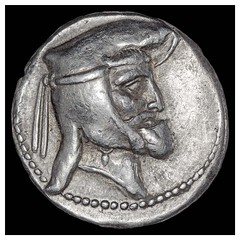
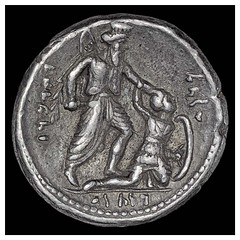
John Nebel writes:
I've been working on an article for The Numismatist on a very odd Persis 3rd cent. B.C. drachma and digging through the associated literature.
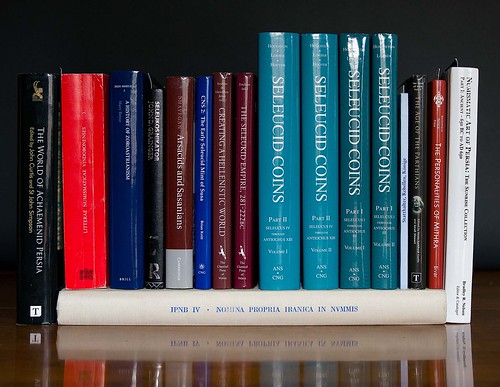
John included images of the coin and associated books. Thanks - we'll look forward to his article. -Editor
Query: What Do These Images Represent?
Jeffrey Wing writes:
Here are images of a coin pictured on a piece of currency. What can E-Sylum readers tell us about it? How old are these? Who are the people in the image? What does the animal represent?
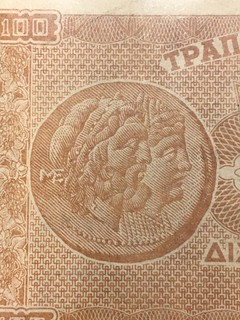
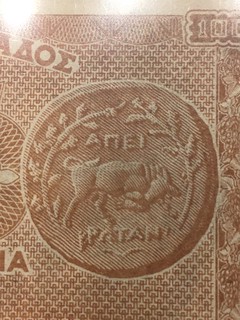
Images of coins on paper money are an interesting specialty. There are many, many examples. Who can tell us about this one? Or better yet, provide images of an actual example of the pictured coin? This should be easy for some of you. Thanks. -Editor

THE COLUMBIA & WASHINGTON MEDAL
Last week Gene Anderson asked about conflicting statements as to the place and time of the ship Columbia's construction as part of his research into the Columbia & Washington medal. First, here's some background on the medal from the Massachusetts Historical Society web site. -Editor
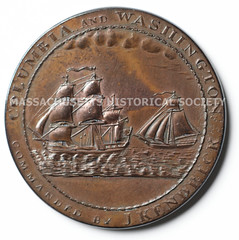
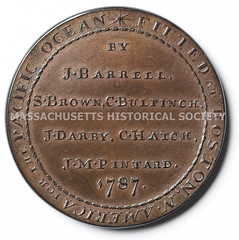
Inspired by the British Royal Society's medals commemorating explorer James Cook's voyages, Boston merchant Joseph Barrell commissioned the Columbia and Washington medal to be sent to the Pacific on the Columbia and Lady Washington in 1787. The bill of lading for the voyage lists 300 medals "to be distributed amongst the Natives on the North West Coast of America, and to commemorate the first American Adventure on the Pacific Ocean." Considered the first die-struck medal issued after American independence, the Columbia and Washington token received considerable attention in contemporary newspaper accounts.
In spite of this notoriety, the origin of the medal remains obscure. While Joseph Barrell probably was solely responsible for its production, neither he nor the newspapers thought to mention the designer, die-maker, or how many medals were struck in each metal used (pewter, copper, and silver).
Anne Bentley of the Massachusetts Historical Society writes:
We show our copper specimen on the web since it was given to us by Joseph Barrell in 1791 and is one of ten which Paul Revere treated for him by filing and polishing the edge.
Cool! Anne also kindly took some time this week to do some checking into the background of the ship. Here are her notes. -Editor
Volume VI of Fairburn's Merchant Sail contains "Index of Vessels", an alphabetical register of all sailing vessels constructed in colonial and federal United States. His list of ships named Columbia contains none built in Plymouth in any year. The Ship Columbia he lists as built in 1773 in Scituate, Mass. He documents it as the Boston/New York consortium China trade vessel that left Boston in 1787 for the Northwest coast and then circumnavigated the globe before setting out again in 1790.
For her second voyage Columbia-Rediviva was registered by her owners as having been built at Plymouth in 1787. I find it very significant that "Previous documentation not shown" forms part of the record here: that indicates to me that she was rebuilt at Plymouth in 1787—not originally constructed there.
Thank you! For background, Anne provided these images of her sources. -Editor

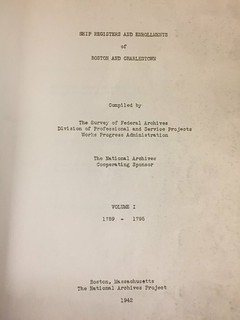
LEFT: HE745 .F3 1945 Fairburn, William Armstrong. Merchant sail. Center Lovell, Me. : Fairburn Marine Educational Foundation, 1945-55. 6 v. (xix, 4179 p.) : chart, tables ; 29 cm RIGHT: HE565.U7 S815 Ship registers of the district of Plymouth, Massachusetts, 1789-1908 / compiled by the Survey of the federal archives, Division of women's and professional projects, Works progress administration. The National archives, cooperating sponsor ... Boston, Mass. : The National Archives Project, 1939-

Merchant sail entries for the Columbia

From Ship registers...
To read the complete article, see:
Columbia and Washington medal
(https://www.masshist.org/database/192)
To read the earlier E-Sylum article, see:
NOTES FROM E-SYLUM READERS: DECEMBER 30, 2018 : Query: Columbia & Washington Medal Ship
(https://www.coinbooks.org/v21/esylum_v21n52a11.html)
ORIENTAL NUMISMATICS AT THE ESSEX INSTITUTE
While looking for other things this week I came across a 1913 book titled A Catalog of the Collection of Books Relating to the Coinage of the East Presented to the Essex Institute Salem, Massachusetts by John Robinson. It's in the public domain and digital copies are available online. Here's an excerpt. -Editor

The collection of coins was begun in 1857—a boy's fancy — and became in later years a recreation from other pursuits. It has so continued, being taken up and dropped again many times; all save the oriental coins having been disposed of long ago. The foundation of the present collection was a number of coins found in a desk belonging to the collector's father, who brought them home from Batavia and Canton — not very many in all, but bringing with them the sentimental interest which all old-time-connected Salemites have for the Far East. The collection as it has taken form is intended to fully represent China and, fairly so, the countries immediately surrounding it; to illustrate the coinage of all countries where oriental inscriptions are found upon the coins, and, incidentally, the places and isles of the sea where Salem ships touched on their eastern voyages and which were familiar names in the counting rooms of the Salem merchants and in so many Salem homes.
Within this scope it is hoped to improve and enlarge the collection as opportunity offers. Just at present important additions are being made to the ancient coins of China. Many parts of the collection are thought already to be sufficiently full for the purpose intended and these groups will not be enlarged, only those of the Far East being much increased. The cabinet containing the collection is so planned that any drawer from among the one hundred and fifty which the base contains may be placed in the upright and sloping, glazed, top sections and changed from time to time at pleasure, without disturbing the coins themselves, and thus vary the portion of the collection publicly exhibited as desired. A number of oriental coins in the Essex Institute collection, including those received from the Salem East India Marine Society, have been incorporated in this collection. The arrangement of the coins in this list necessarily differs somewhat from the catalog of the books, being much more subdivided.
This collection of books and papers has been gathered gradually during the past thirty years, a few have been owned longer, but the larger portion has been obtained within fifteen years. While the chief desire has been to make the series relating to the Far East the most complete, as many books and papers as possible dealing with oriental numismatics in a wider sense have been secured, omitting those relating to the Greek Asiatic rulers. It may appear to some that the Mohammedan countries are unduly represented in this collection, but this has been done purposely to supplement the collection of coins which only includes a comparatively small number from the countries represented by the books in this group.
Besides the books and papers of this collection, there have been added to the catalog the titles of articles on the subject in the books of the China library of the Essex Institute. This special library, now including some three thousand titles, was begun by the gift of a collection of eight hundred volumes on China by the late Thomas Franklin Hunt, and has been greatly augmented from the income of a fund bequeathed in memory of General Frederick Townsend Ward by his sister. This library contains sets of the Journal and Transactions of the Royal Asiatic Society and its China and North China Branches, the China Review and the Chinese Repository, besides many other serial publications printed in or treating of the Far East. It will be noted that from this collection many titles have been obtained.
This catalog is not a bibliography of oriental numismatics. It enumerates only such books and papers as are actually available in the Ward Memorial Room of the Essex Institute, where the cabinet of oriental coins is also kept. The collection of books now seems sufficiently large to make it desirable to print a catalog so that those who are interested in the subject may avail themselves of such assistance as it may supply and which the Essex Institute will gladly extend.
Acknowledgments are due to George Francis Dow, the secretary of the Essex Institute, for his valuable suggestions in regard to the form in which this catalog should be prepared and his constant aid in its preparation ; to Miss Alice G. Waters, the librarian of the Institute, and her assistants, for their many helpful courtesies to an inexperienced catalog-maker; to Henry A. Ramsden, Esq., of Yokohama, for his advice and great help in securing the important numismatic works in the Chinese and Japanese languages and for his valuable letters on the ancient coins of China; and to Mr. Rowland Wood, secretary of the American Numismatic Society, the compiler is greatly indebted for his advice in classifying the books and his assistance in preparing the notes, especially in the Mohammedan series, and for his constant interest.
I never visited the Essex Institute. It merged into the Peabody Essex Museum in 1992. Is anyone aware of what became of the Robinson collection and library? -Editor
To read the complete book, see:
Oriental numismatics : a catalog of the collection of books ... Robinson, John, -approximately 1829.
(https://babel.hathitrust.org/cgi/pt?id=coo1.ark:/13960/t7np2n657;view=1up;seq=9)
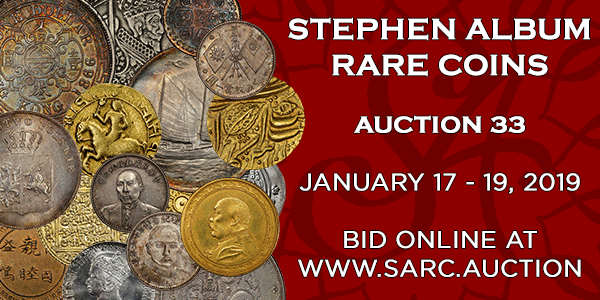
VOCABULARY TERM: CANNELURING MACHINE
Dick Johnson submitted this entry from his Encyclopedia of Coin and Medal Terminology. Thanks. -Editor
Canneluring Machine. A mechanical device for applying a groove to the edge of blanks prior to their being struck; the groove usually contains ornamentation – engrailment – or lettering. Blanks are rolled under pressure between two grooved bars, one of which has lettering or design engraved therein. The lettering or ornamentation is imparted to the edge of the blank in its depressed groove while the edge is somewhat smoothed (the edge may then become slightly smashed by the collar when the piece is subsequently struck in the coining press).
The word comes from the French, canneler, a groove especially in a cylinder. An early canneluring machine for coining purposes was invented by Jean Castaing, thus some are called castaing machines. Modern upsetting machines accomplish a similar smoothing of the edge (but without the groove) and were undoubtedly derived from these early edge-treating machines. See edge, engrailment.
I wasn't aware of that term! Thanks, Dick. Learn something new every week... -Editor
Looking for the meaning of a numismatic word, or the description of a term? Try the Newman Numismatic Portal's Numismatic Dictionary at: https://nnp.wustl.edu/library/dictionary
Or if you would like a printed copy of the complete Encyclopedia, it is available. There are 1,854 terms, on 678 pages, in The Encyclopedia of Coin and Medal Technology. Even running two a week would require more than 19 years to publish them all. If you would like an advance draft of this vital reference work it may be obtained from the author for your check of $50 sent postpaid. Dick Johnson, 139 Thompson Drive, Torrington, CT 06790.
FERDINAND MARIE TRIFET (1848-1899)
 Ferdinand Marie Trifet (1848-1899), was born in Paris, France, September 10, 1848, son of Alexander H. Trifet, a native of Belgium, and Ernestine de Villiers Trifet, a native of Guadalupe, West Indies.
Ferdinand Marie Trifet (1848-1899), was born in Paris, France, September 10, 1848, son of Alexander H. Trifet, a native of Belgium, and Ernestine de Villiers Trifet, a native of Guadalupe, West Indies.
He married on March 12, 1873, Ella F. Sias (1855-), of Ossipee, New Hampshire. They had two children : Grace A. Trifet (1876-), and Louis B. Trifet (1878-).
He came to the United States in 1851 and settled in Brooklyn, New York. In 1856 he went to South America and the West Indies, residing in Havana until 1859, when he returned to the United States. He lived in Washington. Baltimore, Philadelphia, and New York, but came to Boston in 1865, where he has since resided. He attended school in Havana and Washington, but most of his education was under a private tutor.
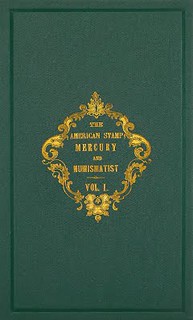 In 1866, at the age of eighteen, he began his business career as importer and dealer in foreign stamps and coins for collectors, now being the longest-established house in that line in America. As a stamp dealer he published The American Stamp Mercury since October-December 1867. The magazine changed its name to The American Stamp Mercury and Numismatist but went defunct in 1871. Tiffany No. 11.
In 1866, at the age of eighteen, he began his business career as importer and dealer in foreign stamps and coins for collectors, now being the longest-established house in that line in America. As a stamp dealer he published The American Stamp Mercury since October-December 1867. The magazine changed its name to The American Stamp Mercury and Numismatist but went defunct in 1871. Tiffany No. 11.
He was a member of the so-called "Boston Gang" of stamp forgers creating fantasy stamps selling bogus as genuine. When Ebenezer Locke Mason, Jr., detected his forgeries and published warnings to collectors in Mason's Coin and Stamp Collector's Magazine, Trifet retaliated in Trifet's American Stamp Mercury and Numismatist, rudely describing Mason as "amusingly stupid," and regrettably "one of the high-pressure kind of human gas bags." This last remark is regrettable and most unfortunate insofar as a few uniformed American numismatists not knowing American philatelic history took Trifet's remarks as though they were worthy of merit and besmirched the name and dignity of Mason as a numismatist and philatelist.
He had a coin auction sale, Catalogue of a collection of American and foreign coins and medals... [Auction sale, Nov. 17, 1869].
In 1880 He lived in Malden, Massachusetts. In the Directory of the City of Malden, 1882, page 131 he is listed as living at 13 Seaview Avenue, Malden, Massachusetts. In 1879 publishing music was added to the stamp business, with the object of furnishing music to the masses of the people in large quantities at small profits. That success attended this undertaking is shown by the fact that Trifet Editions of music and music books were not figured by hundreds or thousands, but by hundreds of thousands and millions; one book alone, Harmonized Melodies, had, in 1899, consumed two hundred and seventy-five tons of paper.
Mr. Trifet became a member of Company G, of the Independent Boston Fusiliers, First Regiment, M. V. M., in 1869, and served eight years. During this service he held the consecutive positions of private, corporal, sergeant, first sergeant, and first lieutenant. He was commissioned first lieutenant of Company G Sept. 6, 1876, and was discharged June 7, 1877.
Lieut. Trifet joined the Artillery Company Sept. 29, 1879; was third sergeant of infantry in 1889 and adjutant in 1897. He received Masonic degrees in Joseph Warren Lodge, of Boston, in 1891, and was a life member of that Lodge. He received the Chapter degrees in St. Andrew's Royal Arch Chapter, of Boston, and he was High Priest of that body at the time of his decease. He was also a member of Boston Commandery, Knights Templars, of the several bodies of the Ancient Accepted Scottish Rite in Boston, Royal Order of Scotland, Fusilier Veteran Association, American Philatelic Association, and of other orders.
Lieut. Trifet died of a brain tumor at his residence, No. 39 Allston Street, Dorchester, Sept. 26, 1899. The funeral services were attended by a large delegation from the Ancient and Honorable Artillery Company.
To read the complete article, see:
TRIFET, FERDINAND MARIE
(https://sites.google.com/a/numismaticmall.com/www/numismaticmall-com/trifet-ferdinand-marie)
The entire inventory of the Lupia Numismatic Library is for sale. Individual items will be available before the remaining archives are broken up into parcels sold at philatelic auctions in the U. S. and Hong Kong. Check NumismaticMall.com frequently as dozens of new items with estimates will be posted daily until everything is sold.
All inquiries will be given prompt and courteous attention. Write to: john@numismaticmall.com .
THE BOOK BAZARRE
ALAN ROY AND CANADIAN NUMISMATIC LITERATURE
On January 1, 2019 Canadian Coin News published the first of two articles by Jesse Robitaille highlighting Canadian numismatic literature. It features E-Sylum contributor Alan Roy. Here's a short excerpt- be sure to see the complete article online. -Editor
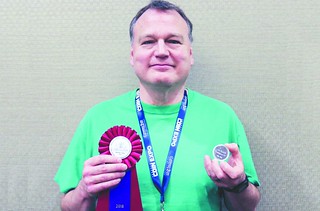 "I like old Canadian numismatic literature," said Roy, who also authors a regular column on the subject in The Canadian Numismatic Journal, the official journal of the Royal Canadian Numismatic Association (RCNA).
"I like old Canadian numismatic literature," said Roy, who also authors a regular column on the subject in The Canadian Numismatic Journal, the official journal of the Royal Canadian Numismatic Association (RCNA).
"I don't care if it's weird, obscure or doesn't have much apparent value; I like anything – even kid's books – and I pretty well don't throw anything away, especially Canadian coin catalogues."
The first catalogue he ever owned was The 1979 Charlton Coin Guide, which reached its 58th edition this year as Canada's oldest continuously published buying guide.
Today, he considers himself a "bibliomaniac," one of three different kinds of numismatic literature collectors.
"They like numismatic literature for its own sake. They get the same satisfaction out of a group of Charlton catalogues as other collectors would get out of a collection of half dollars."
Another type of literature collector, Roy said, is "the researcher," who values the information offered in the books.
"Their library might have some old, worn-out reprints of classic numismatic literature, or they might have photocopies stapled together from the library. These are the people who enjoy tracking a coin through a chain of auction catalogues to figure out its provenance."
In digging for information and publishing their findings, the researcher ensures the hobby's survival.
"They help build the hobby," Roy added.
The last type of literature collector is what he calls the "pure collector, who doesn't understand the benefit of the reference guide."
"They're always chasing that one coin they need for their collection, but they don't really show much of an interest in new reference books. They use reference books kind of like a checklist. A classic example is somebody who would pay $200 for a coin but wouldn't pay $20 for a new reference catalogue."
The "pure collectors" drive bibliophiles batty. As a numismatic literature dealer setting up at coin shows, my old friend John Burns encountered them all the time and loved to complain about them. He didn't have a category label for them, but if he did, rather than "pure collector", I imagine it would be something more like "Dumbass". I'm equally incredulous at their attitudes toward books, but not being a seller of them I didn't have a dog in that fight. To each their own, I suppose. You can lead a horse to a fountain of knowledge, but can't make them drink.
There's a lot more to the article, so click the link below to continue. It has great background on the development of numismatic literature in Canada.
QUICK QUIZ: what two articles published in 1910 are still referenced by collectors today? -Editor
To read the complete article, see:
Literature an affordable offshoot to numismatics
(http://canadiancoinnews.com/literature-an-affordable-offshoot-to-numismatics/)

THE JANIS IAN COLLECTION
We've discussed celebrity coin collectors before, but singer Janis Ian wasn't among them. Here's an article about Ian and her collection from the January 1, 2019 Coin News from Heritage Auctions. -Editor
 Grammy Award-winning singer-songwriter, science fiction writer, activist, philanthropist, and coin collector Janis Ian is perhaps most widely known for her musical career as a teenager in the mid-1960s and into the 1970s. Two hit singles — "Society's Child" and "At Seventeen" — have in some ways defined her career and influenced many people from that generation, although Janis has been extremely active throughout her life (and remains so to this day) using her multiple talents for writing, acting, performing, and advocating many causes. Heritage Auctions has the privilege of offering her collection as a part of the January 9-14 FUN Signature Auction.
Grammy Award-winning singer-songwriter, science fiction writer, activist, philanthropist, and coin collector Janis Ian is perhaps most widely known for her musical career as a teenager in the mid-1960s and into the 1970s. Two hit singles — "Society's Child" and "At Seventeen" — have in some ways defined her career and influenced many people from that generation, although Janis has been extremely active throughout her life (and remains so to this day) using her multiple talents for writing, acting, performing, and advocating many causes. Heritage Auctions has the privilege of offering her collection as a part of the January 9-14 FUN Signature Auction.
We asked Janis about her coin collecting, and she responded:
"Collecting...wow. It was about 1975, "At Seventeen" was just charting, and I passed an interesting-looking museum on 6th Avenue in New York. I went up to Harmer Rooke Galleries and met Leo Dardarian, now sadly passed away. He asked what I was interested in purchasing and I was stunned; I had no idea you could buy rare coins, let alone artifacts. Over the next decades, until he passed away, Leo guided me. He said, always buy things you love. If you buy something just as an investment, and it goes down, you'll be angry. But if you love it, no matter what, you'll still have something you love. Always buy the best coin you can afford, even if it means buying only one.
I bought some of the coins for love, knowing they probably wouldn't increase in value, but most of them, I bought because they excited me. I learned Roman history from coins. I learned that Greece valued beauty enough to have its coins designed by its best artists, unlike the Romans, who were big on absolute reality with not much care for artistic merit. I learned that Roman coins circled the globe in a way nothing else could. And I bought many for the sheer beauty - a chariot whose horses clearly showed their musculature, a shekel that might have been held by one of the disciples or even one of my forebears.
I've held onto these coins and loved them for almost half a century, and now, it's time to part with most of them. I kept a few here and there, but at this time of my life (I'm 67), as we downsize, I'd rather see them go to people who will treasure them and enjoy them, as I have, than sit in a safe somewhere. A large portion of any proceeds from these coins (and my jewelry) will go to the Pearl Foundation. The IRS has restrictions on how much we personally can donate and still remain a public foundation. https://thepearlfoundation.org has all the information."
While many of the coins were ancients, Janis bought a few U.S. coins as well. They appear in this auction — a group of attractive, quality collector coins, scattered throughout the floor sessions including Platinum Night, and the Signature® Internet session. Collectors will find much to admire in this offering, whether it is a problem-free 1877 Indian cent in AU55 NGC, or a remarkably attractive AU58 NGC example of the scarce and underrated 1883 quarter eagle. A highlight of this collection is an 1801 BD-2 eagle, AU55 NGC, with the mysterious vertical spines in Liberty's cap. Others, who admire Janis Ian's work and talent, will bid on the coins as mementos, and love them for that reason.

PAUL NUGGET JOINS DAVID LAWRENCE RARE COINS
This press release from David Lawrence Rare Coins profiles dealer Paul Nugget. -Editor
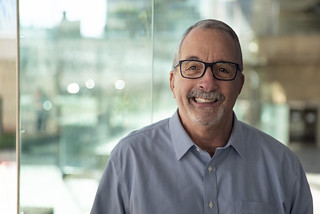 David Lawrence Rare Coins (DLRC) is pleased to announce that world-renowned gold coin specialist Paul
Nugget has joined the company as a new affiliate. Paul, a native New Yorker, will remain in the Empire
State, serving his existing clients as well as helping DLRC serve a wider base of customers.
David Lawrence Rare Coins (DLRC) is pleased to announce that world-renowned gold coin specialist Paul
Nugget has joined the company as a new affiliate. Paul, a native New Yorker, will remain in the Empire
State, serving his existing clients as well as helping DLRC serve a wider base of customers.
Nugget's interest in coins started at eight years old and has propelled him to be the renowned gold coin specialist that he is today. He took a break during adolescence but returned to the hobby after finishing school at Hunter College. After getting a job at a coin shop in July 1969, his knowledge and expertise grew and led to a career in professional numismatics that has lasted almost 50 years. Although Nugget's numismatic fluency covers all U.S. coins, he is most well-known for his specialty in U.S. gold coinage.
Having worked with some of the world's largest gold importers, one of the largest coin wholesalers, as well as the auction house, Stacks'-Bowers, Paul has seen it all and been involved in trading over a billion dollars in U.S. gold coins. Having purchased and sold pieces of practically all classic U.S. gold coins ranging from 1795 to 1933, both federal and pioneer, he is widely known amongst those in the coin industry as one of the foremost experts in his field. While he has a general disdain for Morgan Dollars, his knowledge covers all realms of numismatics.
After venturing solo in the coin business in 2014 and following a brief period of retirement, Nugget decided to join forces with his former mentee and now close colleague, John Brush, the President of DLRC. Brush stated, "I worked with Paul for three years at my first full-time place of employment, Spectrum Numismatics, and Paul took me under his wing in my first week on the job. Not only did he give me a loupe that I still treasure, he was always there to offer support, knowledge, and advice." Brush continued, "Paul not only became a mentor to me, he also became a friend, and we have kept in touch as such over the years. When Paul first told me that he wanted to get back into the business, I immediately jumped on the opportunity and am thrilled to work with him again."
According to Paul, "David Lawrence was a unique opportunity for me to do something that was slightly different than my past professional stops. To work with a wider range of collectors and to assist with the collection of D.L. Hansen was a special opportunity, and I am excited to work with John and the fantastic team at DLRC."
Paul is also a long-time member of the PNG (Professional Numismatists Guild) as well as many other numismatic organizations, and both Nugget, in all his endeavors, and DLRC as a whole are known for their expertise in the hobby and have devoted themselves to the principles of the Professional Numismatists Guild (PNG): honesty, integrity, and reliability, and will continue to provide great value, high quality and unsurpassed customer service.
With Nugget's enthusiasm and over 50 years of experience, the DLRC will continue to make new advances in the Numismatic market as their offerings become more diverse and they are able to offer a deeper and more thorough variety of U.S. gold. Nugget and DLRC are committed to being there for every customer and will offer the best they can provide.
To visit the David Lawrence web site, see:
https://www.davidlawrence.com/
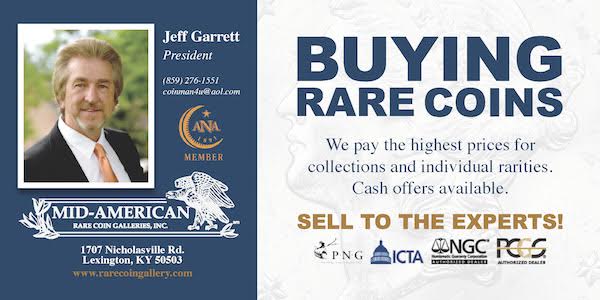
QUIZ: NUMISMATICS AND SPORTS
Pete Smith compiled this interesting quiz on numismatists in sports. It's tough! Who can get the best score? -Editor
The popular image of a numismatist is a man sitting at his desk examining coins with a magnifying glass. Numismatists are not typically known for also engaging in strenuous sport. This quiz tests your knowledge of Numismatists also known for accomplishment in sport.
1. Who won the first gold medal at the 1896 Olympics in Athens?
2. In early Olympics there was an event called the "Plunge" that involved swimming a distance underwater. What numismatist took a silver medal in this event?
3. What living numismatist has scored ten perfect 300 games bowling?
4. What coin collector is in the American Bowling Congress Hall of Fame and the Professional Bowlers Association Hall of Fame?
5. What numismatist earned a Worlds Series ring in 1984?
6. What numismatic author scored seven holes-in-one golfing?
7. What coin collector was inducted into the International Game Fishing Association Hall-of- Fame?
8. What numismatist climbed 32 mountains greater than 14,000 feet?
9. What professional basketball player served on the Citizens Coinage Advisory Committee?
10. What member of the ANA Numismatic Hall of Fame was partial owner of the Texas Rangers baseball team?
11. What numismatist once owned the Los Angeles Lakers in the NBA?
12. Name two coin collectors who owned the Los Angeles Kings in the NHL.
13. Who owned the Indiana Pacers basketball team?
14. Who was captain of a national championship cycling team?
15. I am aware of a coin collector who has completed 37 marathons. Can you identify him or any collector who has completed more marathons?

BURGLARY AT LEU NUMISMATIK
Rickie Rose of Lynchburg, VA forwarded a notice from Leu Numismatik of Switzerland. Many coins sold in their December 9, 2018 Web Auction 6 were stolen in a burglary as they were being prepared for post-Christmas shipment. A full list including pictures and short descriptions can be found on their web site at the below address. There are many lovely and distinctive coins here - be on the lookout in the marketplace. -Editor
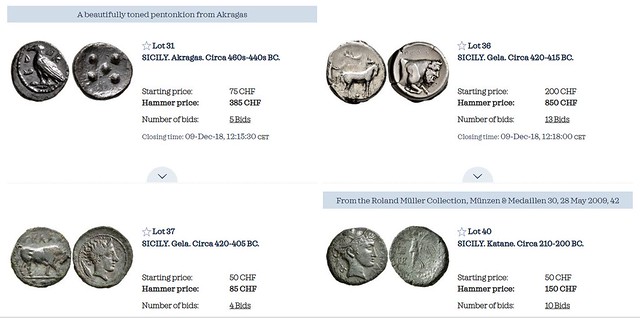
To read the complete list, see:
Web Auction 6 – Stolen Lots
(https://leunumismatik.com/9382hf3wj98fcwq0u721sdcc)
BONHAMS OFFERS CLARK GRUBER TERRITORIAL GOLD
Art Daily reported that the upcoming Bonham's sale includes a complete set of Clark Gruber & Co. territorial gold coins. -Editor
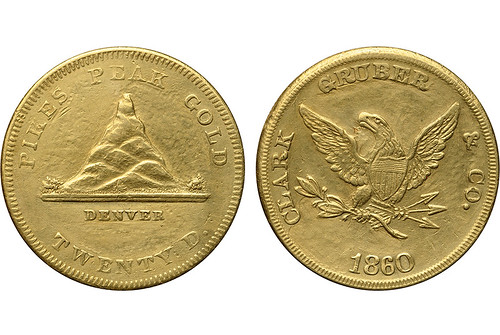
On January 28, Bonhams sale of Coins and Medals will feature a complete set of Clark Gruber & Co. Territorial gold coins minted in 1860-1861 in Denver, Colorado, which was amassed over several decades. This set includes the quarter eagles, half eagles, eagles, and the ultra-rare double eagles from both dates issued, 1860 and 1861. Multiples of certain dates and denominations are also part of the collection resulting in the largest grouping of Clark Gruber & Co. gold offered on the market for many decades with estimates ranging from $1,500 to $90,000.
A decade or so after the California Gold Rush began in the late 1840s, gold was discovered on the South Platte River, near the future city of Denver. Clark, Gruber & Co., a reputable bank and brokerage firm in the state, established a coinage facility and remained in operation through 1862. It was elbowed out of the coining business in April 1863 when it was turned first into a federal assay office, then 43 years later, into the Denver branch of the United States Mint in 1906.
To read the complete article, see:
Bonhams to offer an important collection of Clark Gruber & Co. Territorial gold
(http://artdaily.com/news/110321/Bonhams-to-offer-an-important-collection-of-Clark-Gruber---Co--Territorial-gold#.XDFSh1xKiAs)
For more information, see: https://www.bonhams.com/auctions/25528/

DAVISSONS AUCTION 38 CLOSES FEBRUARY 27TH 2019
Here is the press release for Davissons upcoming Auction 38. Great variety and many top-notch coins, tokens and medals. -Editor
Davissons Auction 38, Closing February 27th 2019
 Davissons annual mail/internet auctions are the culmination of a year of purchases
and consignments. The most appealing and interesting lots acquired over the course
of the year are held for this auction.
Davissons annual mail/internet auctions are the culmination of a year of purchases
and consignments. The most appealing and interesting lots acquired over the course
of the year are held for this auction.
A highlight of their 38th major auction is a group of some of the finest crowns of Charles I to appear on the market in one sale since the Tallent Sale in 2008. Many come with century old pedigrees from famous collections whose former owners, Montagu, Slaney, Lingford, Brooker, Rashleigh, Cooper, Paget, represent a "who’s who" of 20th century numismatics, and some of these pieces were rated by their owners as among the finest.
The sale opens with choice gold—ancient, world, some choice English hammered, and early U.S. gold, including one of the great rarities in the US currency gold issues, an 1861 Dahlonega dollar from the John Jay Pittman collection.
The ancient section covers, in a compact but select offering, Spain, Sicily with some beautiful tetradrachms, Macedon and Thrace and the beauty of Hellenistic dies on large silver, classic silver of Asia Minor, and a fascinating section of seldom seen Roman Provincial issues, the Koinon of Macedon series. Of particular note is an offering of Alexander type tetradrachms from less often seen mints such as Sinope and Myrina, and a beautifully toned Lycian tetradrachm of Mithrapata. Roman Imperatorial portraits of Julius Caesar (ex LaRiviere), Antony and Cleopatra, and Octavian follow several beautiful Roman Republic denarii. The Imperial section includes an exceptionally fine Nero sestertius.
The British trade token offering is made up of the Dr. Harry Salyards collection, and is an exceptional group. Dr. Salyards is the editor of Penny-Wise, the long-running publication of Early American Coppers, Inc. He built his collection to represent the counties as D&H defined them and his eye for quality is evident in the tokens. His enthusiasm is also evident in the many detailed notes he made on many of the envelopes holding his tokens. The envelopes and their liners accompany each of the pieces.
A selective smattering of coins from an extended late 20th century collection of American coins provides an important section near the end of the sale. A couple of rare highlights are featured: in the beginning gold section the John Jay Pittman example of the extremely rare, and series key, 1861 Daholnega gold dollar and at the sale's penultimate point a well worn but very presentable silver example of a St. Patrick farthing are but two of the historic American coins in this section. It continues with some choice Colonial copper, and a select array of U.S. type. For the most part the coins are "raw" and cataloged using conservative British and European grading standards. (For example, the grade "AU" does not exist for most of our numismatic colleagues across the ocean.)
The auction closes with historic medals (including an example of the Manly medal of George Washington), and a few pieces of fine ancient coinage-inspired jewelry.
The entire sale is available online at www.davcoin.com. The sale is also available in a high quality printed catalog, free on request.
There are no buyer's fees in Davissons auctions. UK bidders may pay in British pounds directly to a UK account. Bids can be placed online at www.davcoin.com, via email, info@davcoin.com, or via regular mail: Davissons, PO Box 323, Cold Spring, MN 56320 USA.
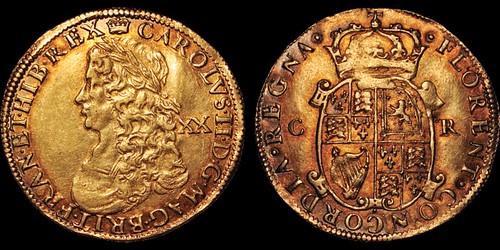
Lot 10 Charles II. AV unite. Ex Michael S. Tallent Collection. Estimate: $10,000

Lot 36 SICILY. Leontini. AR tetradrachm. Estimate: $4500

Lot 71 Roman Republican. L. Plautius Plancus. AR denarius. Estimate: $1500
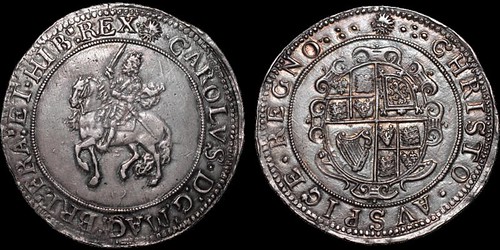
Lot 117 Charles I. AR crown. Ex John Brooker Collection (SCBI Brooker 274, this coin). Estimate: $16,500
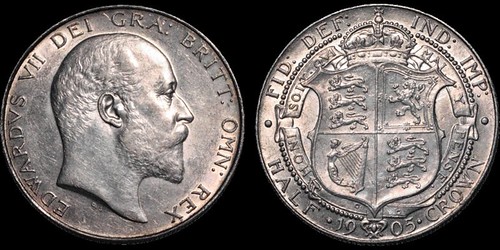
Lot 157 Edward VII. AR halfcrown. 1905. The key silver currency rarity in 20th century English coinage. Estimate: $6500
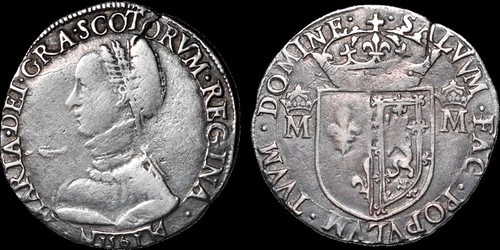
Lot 164 Scotland. Mary Stuart. AR testoon. Estimate: $7500

Lot 213 Middlesex 290. London, Piccadilly. London Corresponding Society. Æ halfpenny. Estimate: $850

Lot 338 United States. William Pitt, the Elder. Repeal of the Stamp Act. AR medal. Estimate: $1000
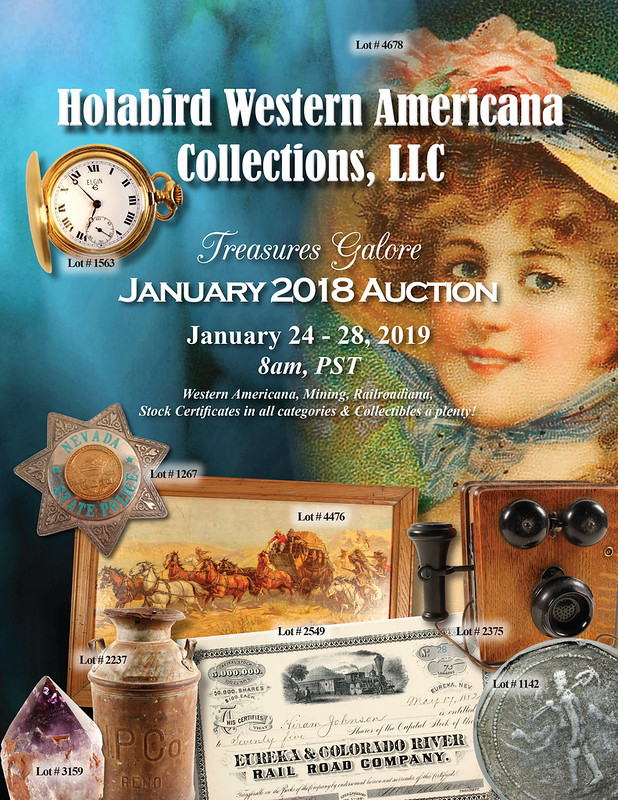
RAY CZAHOR PHILIPPINES SALE SELECTIONS
Kyle Ponterio of Stack's Bowers Ponterio published a blog article this week on the consignment from Ray Czahor of Philippines coinage, patterns and medals. -Editor
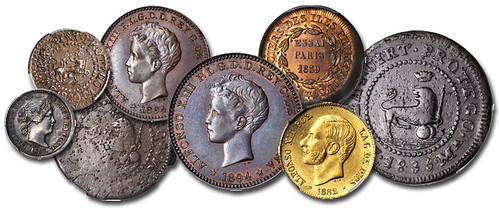
Stack's Bowers Galleries is pleased to highlight another installment of the famous collector-numismatist Mr. Ray Czahor, to be featured in our auction held in conjunction with the 47th annual New York International Numismatic Convention (NYINC). The auction takes place at the Grand Hyatt Hotel, located on 102 East 42nd St. in New York City on January 11 and 12 for the floor sessions and January 14 and 15 for the Internet only sessions.
A long time collector, Ray has sought out the best examples, assembling impressive collections of many different types and time periods, primarily relating to the Philippines. The early machine struck Philippines coinage consigned to the 2019 NYINC auction reflects his decades long search to find pieces that met or exceeded his stringent criteria.
In the early days, the manufacturing process at the provincial mint of Manila was crude and rudimentary and showed much variation. Many issues are in less than desirable condition due either to prolonged circulation or other impairments. The overall quality of the pieces Ray acquired is a testament to his incredible patience, an attribute that is foundational in the formation of a transcendent collection. The lots discussed in this article give an excellent representation of the many fantastic pieces Ray spent years acquiring.
The early copper issues are of particular interest since these were used in daily transactions. Usually found badly corroded and worn, many of the pieces presented in the auction are attractive, problem free and vastly superior to most encountered on today's market.
The qualities that Ray valued: strong even strikes, good metal quality, fullness of details and overall nice appearance are evident in the coins featured in the auction.
To read the complete article, see:
Another Installment from the Ray Czahor Collection of Philippines
(https://www.stacksbowers.com/News/Pages/Blogs.aspx?ArticleID=3234)
Kyle listed a number of his favorite lots. See the blog article for the full list and links to the lot descriptions. Here's a subset that I have room to share here. Great material. -Editor
Lot 41290: 1835 Philippines 4 Quartos
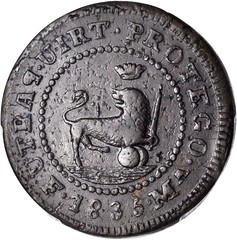

Exceptional 4 Quartos of Isabella II
PHILIPPINES. 4 Quartos, 1835-MA F. PCGS VF-35 BN Gold Shield.
KM-15; Basso-46; Cal-Type 179 #713. Globes closely spaced. EXTREMELY RARE type in this state of preservation. Unusually well prepared planchet with minimal defects and a unusually bold strike leaving clear details. Bold complete legends and devices. Vastly superior to the other examples we were able to locate with far less in the way of planchet defects or striking deficiencies. Lovely smooth fields with rich patina. An example where the grade on the holder certainly does not reflect the overall quality. If not the finest example extent certainly one of the finest. A chance not to be missed as the opportunity to acquire such a tremendous highly sought after piece may not occur again for many years.
Ray's one of those nice, quiet collectors who piece-by-piece assembles an amazing collection of high quality rarities. Specialists have a unique opportunity to study their subject matter, continually upgrade and be ready when great pieces come to market. This sale will provide many opportunities for the next generation of Phillippines collectors. -Editor
To read the complete lot description, see:
PHILIPPINES. 4 Quartos, 1835-MA F. PCGS VF-35 BN Gold Shield.
(https://auctions.stacksbowers.com/lots/view/3-FM7VK)
Lot 41292: 1857 Philippines Pattern Peso
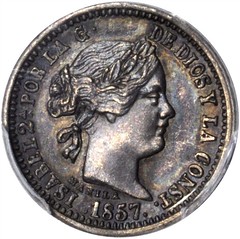
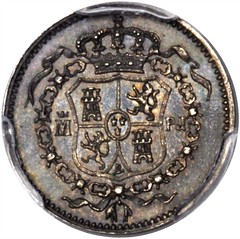
Proposed Gold Pattern Struck in Silver
PHILIPPINES. Pattern Peso Struck in Silver, 1857. Madrid Mint. PCGS SP-64 Gold Shield.
KM-Pn2(listed as a Real), Basso-75(72), Cal-unlisted. Plain edge. A pattern struck in silver for a projected gold peso which eventually became KM-142. Superior to the previous two records we were able to locate. The most recent being of an NGC MS-63 sold in the Auction World Co., Ltd Auction #13 July 14, 2018 Lot #1376 where it hammered for an impressive 1,200,000 Yen (approximately $10,676). The other example was graded NGC VF-30 in the Heritage CICF auction April 10, 2014 Lot #25628 where it hammered for $2,000-. The consignor notes that this was the only example he could recall seeing in 50+ years of collecting. An exceptional example with sharp devices and intricate details. Though this pattern is certainly not unique it is without a doubt EXTREMELY RARE and highly sought after and destined to be a highlight of any collection of Philippines. Deeply toned with hints of iridescence.
To read the complete lot description, see:
PHILIPPINES. Pattern Peso Struck in Silver, 1857. Madrid Mint. PCGS SP-64 Gold Shield.
(https://auctions.stacksbowers.com/lots/view/3-FM7VV)
Lot 41295: 1859 Philippines Paris Mint 80 Reales Pattern
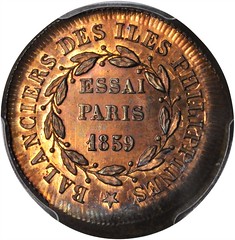
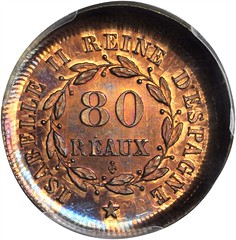
PHILIPPINES. Broadstruck Pattern 80 Reaux (Reales) Struck in Copper, 1859. Paris Mint. PCGS SP-66 RB Gold Shield.
KM-Pn16; Bruce-Pn5; Basso-81. Small date, large star. Intended patterns for gold coins. EXTREMELY RARE and probably UNIQUE. Struck without collar creating a dramatic error where the planchet is slightly out of round and bowed. Partial raised edges on either side. Boldly struck with clashed dies, sharp devices with reflective surfaces and splashes of attractive lavender, blue, purple and plenty of original mint red.
Very unusual. A great piece! -Editor
To read the complete lot description, see:
PHILIPPINES. Broadstruck Pattern 80 Reaux (Reales) Struck in Copper, 1859. Paris Mint. PCGS SP-66 RB Gold Shield.
(https://auctions.stacksbowers.com/lots/view/3-FM7AV)
Lot 41302: 1894 Philippines Pattern Centavo
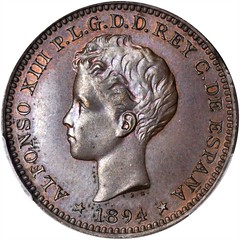
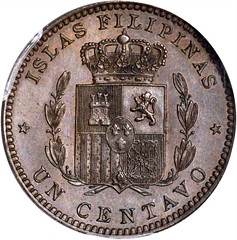
Exceptional 1894 Pattern Centavo
PHILIPPINES. Pattern Centavo Struck in Copper, 1894. Madrid Mint. PCGS SP-64 BN Gold Shield.
KM-Pn18; Basso-93; Cal-pg. 844. Bust of young King Alfonso XIII facing left; Reverse: Coat of Arms with half-wreath. Far less encountered than its larger denomination counterpart the 2 Centavos. Superior to the example sold in the Cayon auction December 11, 2012 lot #1140 where it hammered for 15,500 Euro (approximately $20,000) plus buyers fee. EXTREMELY RARE and highly sought after. Sharply struck displaying lovely mahogany surfaces with hints of cinnamon at the periphery. A choice pattern never intended for circulation, and seemingly spared from.
Great piece. I don't believe I've seen any of the coins in this article before. Some great rarities. -Editor
To read the complete lot description, see:
PHILIPPINES. Pattern Centavo Struck in Copper, 1894. Madrid Mint. PCGS SP-64 BN Gold Shield
(https://auctions.stacksbowers.com/lots/view/3-FM7DB)
Lot 43816: 1834 Philippines Quarto
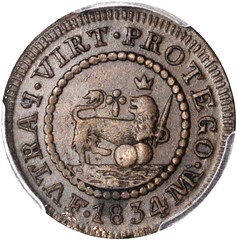
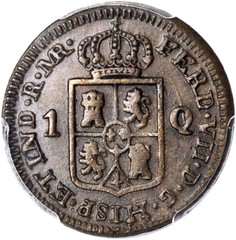
PHILIPPINES. Quarto, 1834-MA F. Ferdinand VII (1808-33). PCGS AU-50 Gold Shield.
KM-10; Basso-41b; Cal-Type 438 #1597. Large lion with tail curving over back. VERY RARE in this state of preservation. Our first offering of this one year type struck for Ferdinand VII. An astounding example, well struck with smooth brown fields. Likely undergraded, as we consider the flat areas on the lions and castles to be striking weakness rather than wear. A splendid example and probably one of the finest extent being light years ahead of what is normally encountered.
Nice coin and a standout for condition. -Editor
To read the complete lot description, see:
PHILIPPINES. Quarto, 1834-MA F. Ferdinand VII (1808-33). PCGS AU-50 Gold Shield.
(https://auctions.stacksbowers.com/lots/view/3-FMPWA)
Lot 43821: 1859 Philippines 2 centavos Pattern

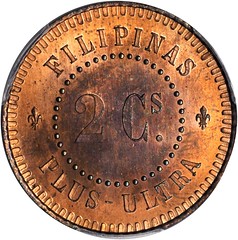
PHILIPPINES. 2 Centavos Pattern, 1859. PCGS SP-65 RB Gold Shield.
Basso-74; KM-Pn12. A real beauty. Sharply struck with copious amounts of blazing mint luster.
Plain design, but a beautiful piece. -Editor
To read the complete lot description, see:
PHILIPPINES. 2 Centavos Pattern, 1859. PCGS SP-65 RB Gold Shield.
(https://auctions.stacksbowers.com/lots/view/3-FMNNK)
Lot 43822: 1861 Philippines 2 Reales Proclamation Medal
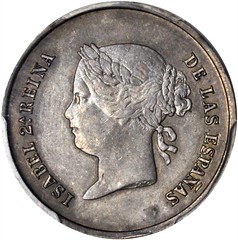
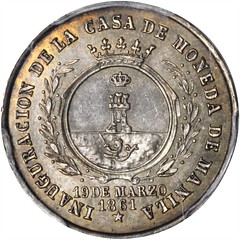
PHILIPPINES. Silver Proclamation 2 Reales Medal for the Inauguration of the Manila Mint, 1861. PCGS AU-55 Gold Shield.
5.22 gms. Basso-96; Honeycutt-16. RARE. Struck to commemorate the opening of the Manila mint March 19, 1861. The Royal decree of September 8, 1857 was specific to the authorization of gold coinage. Obverse: Bust of Isabella II left; Reverse: Arms of Manila in wreath, legend around, date below. Well struck with lovely smooth grey tone highlighted with sunset hues in the peripheries. Plenty of underlying luster in the protected areas. A wholesome attractive example that rarely appears on the market destined for an advanced collection.
Proclamation medals are an interesting area to collect, and deserve a place alongside a country's coins and patterns. -Editor
To read the complete lot description, see:
PHILIPPINES. Silver Proclamation 2 Reales Medal for the Inauguration of the Manila Mint, 1861. PCGS AU-55 Gold Shield.
(https://auctions.stacksbowers.com/lots/view/3-FMPV0)

NUMISMATIC NUGGETS: JANUARY 6, 2019
Here's a selection of interesting or unusual items I came across in the marketplace this week. Big group this time. Tell us what you think of some of these. -Editor
Moesia, Istros Silver Stater
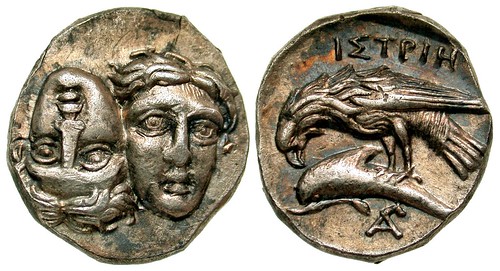
Moesia, Istros. 450-300 B.C. AR stater (18.1 mm, 5.82 g, 6 h). Two young, male heads facing, the left inverted / IΣTPIH, sea-eagle left standing on dolphin left, which it attacks with its beak; AΠ monogram beneath dolphin. AMNG 417; SNG Copenhagen 195. EF, toned.
Unusual juxtaposition of heads; this is rarely seen in coin and medal design. Nice piece. From Agora Auctions sale #81 closing January 22nd. -Editor
To read the complete lot description, see:
Lot 020. Moesia, Istros. 450-300 B.C. AR stater. From the D.Thomas Collection.
(https://www.agoraauctions.com/listing/viewdetail/42483)
1799 Gilt Copper George III Proof Halfpenny

Great Britain. George III (1760-1820). Gilt Copper Proof Halfpenny, 1799. Laureate, draped bust right, rev. Britannia seated left, date below. S.3778. NGC PF 65 ULTRA CAMEO.
From the SPINK 2019 NYINC sale. I don't believe I've seen a Gilt Copper Proof before. Nice. -Editor
To read the complete lot description, see:
https://spink.com/lot/344000130
1912 Roald Amundsen Token
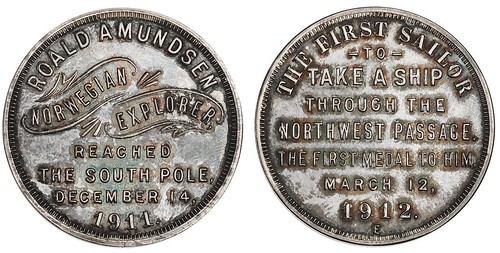
Roald Amundsen (1872-1928). Tribute Token in Silver, 1912. 31mm, 16.0 gms. Issued by Thomas Elder, NY. ROALD AMUNDSEN / NORWEGIAN EXPLORER (on banner) / REACHED / THE SOUTH POLE / DECEMBER 14, / 1911, rev. THE FIRST SAILOR / -TO- / TAKE A SHIP / THROUGH THE / NORTHWEST PASSAGE. / THE FIRST MEDAL TO HIM, / MARCH 12, / 1912, small E below. DeLorey 16. Extremely rare with only 5 pieces believed struck in Silver by Charles Hanson, Chicago. Iridescent toning. About Uncirculated.
Interesting Tom Elder piece in the SPINK 2019 NYINC sale. -Editor
To read the complete lot description, see:
Roald Amundsen (1872-1928). Tribute Token in Silver
(https://spink.com/lot/344000895#)
1901-O Morgan Dollar

RARE 1901-O MORGAN SILVER DOLLAR WITH LIGHT GOLDEN TONING GRADED MS64 BY INVESTMENT RARITIES INC - THIS COIN IS VERY RARE AND HARD TO COME BY IN THE UPPER GRADES.
As with all grading services, grading standards may vary and this grading service's standards may or may not match other grading services' standards. Please bid accordingly
What's interesting about this one is the certificate. The seller implies that it's from a grading service, but it's just marketing material supplied by an earlier coin seller.
I've never heard of this person or company - Dennis Wegley of Investment Rarities Incorporated. A search on the Newman Numismatic Portal finds mentions of his name in the 1980s.
The Spring 1982 issue of The N.A.S.C Quarterly lists him as a new member of the Numismatic Association of Southern California.
A 1983 Coin World article lists him as a convention panelist discussing "advantages of investing in Morgan and Peace silver dollars"
A 1985 Currency Dealer Newsletter lists him as a speaker at the Seventh National Silver Dollar Convention in St. Louis.
All the hits on his name were in the span 1982-1986. A general web search found his name in the January/February 2013 issue of the TNA News from the Texas Numismatic Association within an ad for the National Silver Dollar Roundtable. "Dennis E. Wegley" is listed under "In Memorium."
So we know he was active as a dealer in silver dollars in the mid-1980s and died sometime before mid-2013. Can anyone provide more information? -Editor
To read the complete lot description, see:
RARE 1901 O MORGAN SILVER DOLLAR
(https://www.seizedpropertyauctions.com/RARE_1901_O_MORGAN_SILVER_DOLLAR-LOT4466.aspx)
1938 Canadian 10 Cent
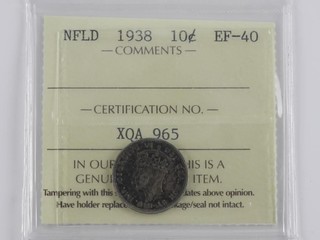
NFLD 1938 - 10 Cent EF-40 ICCS.
Here's another certified item; I think this is from the International Coin Certification Service (ICCS) in Canada. What does "NFLD" mean? -Editor
To read the complete lot description, see:
NFLD 1938 - 10 Cent EF-40 ICCS.
(https://auction.auctionnetwork.ca/NFLD-1938-10-Cent-EF-40-ICCS_i32253506)
Tromp L'oeil Engraving of French Paper Money
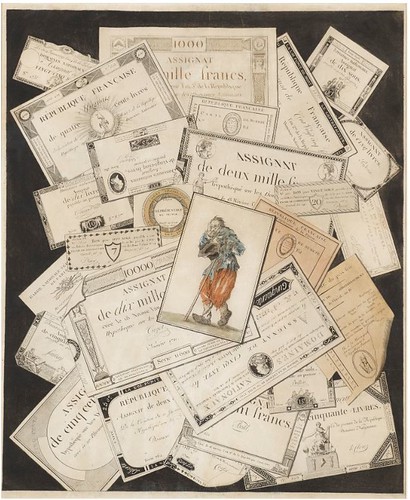
Nicolas Marie Gatteaux (after) [TROMPE L'OEIL OF PAPER MONEY AND OTHER PRINTED FINANCIAL EPHEMERA]
Engraving, coloured by hand, by Tardieu, after Gatteaux, circa 1792. Louis XVI style gold leaf frame. sheet size: 812 by 679 mm 32 by 26 3/4 in
This one's from Sotheby's. -Editor
To read the complete lot description, see:
Nicolas Marie Gatteaux (after)
[TROMPE L'OEIL OF PAPER MONEY AND OTHER PRINTED FINANCIAL EPHEMERA]
(http://www.sothebys.com/en/auctions/ecatalogue/2019/important-americana-n10005/lot.1602.html)
Colorized Silver Eagles
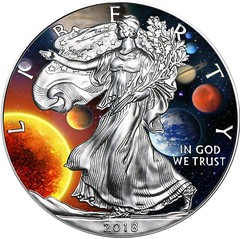

2018 1 Oz $1 Colorized SOLAR SYSTEM EAGLE Coin.
Here's another form of numismatic artwork. These two images are from eBay. The second one (2015-dated) must be from a closed sale - I grabbed it from Google, but couldn't locate the listing. Anyway, these managed to catch my eye. Many (OK, most) of these colorized concoctions are dreck, but some can still look pretty. -Editor
To read the complete lot description, see:
2018 1 Oz $1 Colorized SOLAR SYSTEM EAGLE Coin.
(https://www.ebay.com/itm/2018-1-Oz-1-Colorized-SOLAR-SYSTEM-EAGLE-Coin/283318847350)
To see the Google image listing: https://goo.gl/images/JZvELh
THE BOOK BAZARRE
JANUARY 2019 MEDAL SELECTIONS FROM NUMISMAGRAM
Jeremy Bostwick from Numismagram passed along some highlights from his most recent offering of medallic art. Listed below is another example of the interesting Nitroglycerin piece which elicited some reader input last summer. In addition to these medals, you will find a few other incredibly artistic nude medals, some early 20th century French award medals, a couple interesting WWI-related pieces, a Centennial 'wood,' a couple other aviation types featuring a Zeppelin, and a pair of Brookgreen Gardens medals. To see all of the new items, visit numismagram.com/inventory . -Editor
U.S.-Brazil Epitácio M. Pessoa Medal
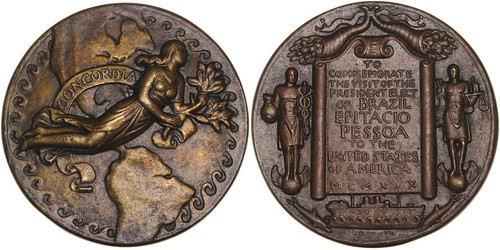
UNITED STATES & BRAZIL. President-elect Epitácio M. Pessoa bronze Medal. Issued 1919. Commemorating his Visit to the United States (77mm, 207.50 g, 12h). By P. Manship. Concordia flying right, holding olive branches and with eponymous banner trailing; view of the western hemisphere, prominently displaying the United States and Brazil, in background / Scroll inscribed TO / COMMEMORATE / THE VISIT OF THE / PRESIDENT ELECT / OF BRAZIL / EPITACIO / PESSOA / TO THE / UNITED STATES / OF AMERICA / MCMXIX in eleven lines; garlanded cornuacopiae above; allegories of trade standing facing, holding purse and caduceus (on the left) and scroll and scales (on the right); below, steam ship sailing right between two dolphins. Edge: Plain. Cf. Smithsonian no. 1965.16.84 (for an example presented to the museum by Paul Manship himself). Choice Extremely Fine. Yellow-brown surfaces, with high relief on the obverse; some minor spotting and roughness. A very rare and interesting piece of a desirable medalist. Far superior to the Smithsonian piece. $595.
Epitácio Pessoa served as the 11th President of Brazil from 1919-1922, coming to the presidency in an unusual manner. Former president Francisco de Paula Rodrigues Alves had won the 1918 election with an astounding 99.1% of the vote, but was stricken with the Spanish flu during 1918's global pandemic of influenza, was unable to be sworn in, and ultimately died in January 1919. His vice-president-elect, Delfim Moreira da Costa Ribeiro was sworn in, though health issues surrounded him as well. Having successfully negotiated for Brazil's interests at the Treaty of Versailles, Pessoa defeated Ruy Barbosa de Oliveira in a snap election to be Brazil's next president–with Delfim Moreira being relegated to vice-president–without Pessoa having even left France.
Unusual obverse. I like it. -Editor
To read the complete lot description, see:
100499 | UNITED STATES & BRAZIL. President Epitácio M. Pessoa bronze Medal.
(https://www.numismagram.com/product-page/100499)
Sweden Edlund & Nauckhoff Medal

SWEDEN. Carl August Edlund & Sigurd Nauckhoff bronze Medal. Issued 1939. Commemorating the 75th Anniversary of the Nitroglycerin Aktiebolaget (Nitroglycerin Corporation) (56mm, 68.97 g, 11h). By E. Lindberg. CARL AUGUST EDLUND • SIGURD NAUCKHOFF / NITROGLYCERIN AKTIEBOLAGET 1864–1939, busts of Edlund and Nauckhoff left / VINCIT VIS MEA SAXUM (my strength overpowers the stone), nude male left, pushing apart the rocky earth. Edge: BRONS 1939. Choice Mint State. Pleasing brown surfaces, with a light matte finish. Includes original roundelle. $165.
Known for inventing dynamite and bequeathing his fortune in order to fund what would become the Nobel Prizes, Alfred Nobel was a prolific inventor who held over 350 patents. In 1864, he founded the Nitroglycerin Aktiebolaget (Nitroglycerin Corporation), the world's first manufacturer of nitroglycerin. Over the years, the corporation was guided under the leadership of various managing directors, such as Sigurd Nauckhoff, serving from 1921-1944, and Carl August Edlund, succeeding him from 1944-1965. Following Edlund's tenure, the corporation's name was changed to Nitro Nobel, and was changed again in 1999 to Dyno Nobel Sweden.
Great medal. -Editor
To read the complete lot description, see:
100540 | SWEDEN. Carl August Edlund & Sigurd Nauckhoff bronze Medal.
(https://www.numismagram.com/product-page/100540)
U.S.-Spain Christopher Columbus Medal

UNITED STATES & SPAIN. Christopher Columbus bronze Medal. Issued 1892. The 400th Anniversary of the Discovery of the New World/Quartercentenary (70mm, 179.65 g, 12h). By B. Maura y Montaner in Madrid. "Cristobal Colón descubrió el Nuevo Mundo el doce de Octubre de mil cuatrocientos noventa y dos, reinando en Castilla y Aragon Doña Isabel y Don Fernando," Columbus standing left in Santa Maria, head right, pointing out the sight of land; crew mates to right; in background, Nina and Pinta upon the sea / Columbus preparing to kneel right before Ferdinand and Isabella at their double throne; in background to left, Native Americans bearing gifts; "Cuarto centenario" in exergue. Edge: Plain, though a few light marks and a very minor rim nick are mentioned merely for completeness. Eglit 111; Rulau B2. Choice Mint State. Glossy chocolate brown surfaces, with a great deal of underlying luster. Very rare and attractive. $465.
In order to commemorate the 400th anniversary of the Columbian discovery of the New World, the Academy of Fine Arts of San Fernando established a competition for a work of medallic art. Bartolome Maura y Montaner produced one of the finest designs within the Quartercentenary series, Spanish or otherwise, though his initial work was not selected due an anachronism. The kneeling crew mate on the obverse of the above design had originally been a friar praying on both elbows and knees. As the historical record pointed to no ecclesiastic members aboard the voyages of Columbus, Maura y Montaner yielded and replaced the individual, leaving the remainder of the obverse and reverse virtually unchanged.
Very attractive piece. Busy design, but quite nicely done. It works well. -Editor
To read the complete lot description, see:
100419 | UNITED STATES & SPAIN. Christopher Columbus bronze Medal.
(https://www.numismagram.com/product-page/100419)
U.S.-Germany Coolidge & Eckener Medal
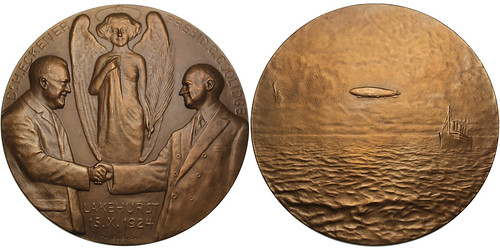
UNITED STATES & GERMANY. Calvin Coolidge & Hugo Eckener bronze Medal. Issued 1924. Commemorating the Landing of the LZ 126 (USS Los Angeles) in Lakehurst, New Jersey (64mm, 98.46 g, 12h). By T. Isnenghi. DR H ECKENER PRESID C COOLIDGE / LAKEHURST 15 X 1924, half length busts of Eckener and Coolidge facing one another, clasping hands; between them, facing figure of Peace, holding palm frond / Airship flying left over the Atlantic Ocean; Statue of Liberty at a distance to left; to right, steam ship sailing left. Edge: Plain. Hans Kaiser Coll. 455.1, Button –; Westfälische Auktionsgesellschaft 58, lot 2718. Choice Mint State. Pleasing light brown surfaces, minor fingerprinting on the reverse. Extremely rare, with just one other specimen listed on CoinArchives (an inferior piece, which realized a hammer of €425 in 2011). $695.
Following the death of the Graf von Zeppelin in 1917, Dr. Hugo Eckener became the head of the company Luftschiffbau Zeppelin and oversaw post-war fundraising to expand upon its production, even serving as commander for the LZ 126 and LZ 127. Built as a part of the German reparations for their participation in WWI, the LZ 126, designated by the US Navy as the USS Los Angeles, was completed in August 1924 and flown to the United States later that October, landing at the US Naval Air Station in Lakehurst, New Jersey. The next day, Eckener, along with his crew, was received by President Calvin Coolidge at the White House.
Nice medal. I especially like the impression of great distance on the reverse. -Editor
To read the complete lot description, see:
100543 | UNITED STATES & GERMANY. Calvin Coolidge & Hugo Eckener bronze Medal.
(https://www.numismagram.com/product-page/100543)

THE COINAGE OF HERACLIUS
Mike Markowitz of CoinWeek published a nice article on the coinage of Heraclius - "The Greatest Emperor You’ve Never Heard of". Here's a short excerpt - be sure to read the complete article online for great information and coin images. -Editor

AFTER THE COLLAPSE OF the Roman Empire in the West (476 CE), the Eastern Empire, with its capital at Constantinople, survived for another 977 years. We call that empire "Byzantine", but it called itself Roman, or rather Romaion, because its language was Greek, and its faith was Orthodox Christian.
Much of the credit for this survival goes to Heraclius (or Herakleios), who began his career as a rebel against a brutal tyrant, and ended it by founding a dynasty that endured four tumultuous generations.
The complex coinage of Heraclius is mostly common and affordable, offering endless challenge and delight for collectors. In 1982, the late great numismatist Philip Grierson wrote, "…the coins are of such slovenly fabric that they have been little sought after by collectors (p. 85)." The growing number of enthusiastic Byzantine collectors,and the strong bids these coins often bring at auction, indicate how this has changed.
To read the complete article, see:
CoinWeek Ancient Coin Series – Heraclius: The Greatest Emperor You’ve Never Heard of
(https://coinweek.com/ancient-coins/coinweek-ancient-coin-series-heraclius-the-greatest-emperor-youve-never-heard-of/)

HUDSON'S BAY COMPANY MADE-BEAVER TOKENS
The January 2019 issue of Alaskan Token Collector and Polar Numismatist published by Dick Hanscom includes a short article relating to the Hudson's Bay Company Made-Beaver tokens. It's republished here with permission. Thanks. -Editor
H.B.C. "MADE BEAVERS"
Below is transcribed a letter that was sold on eBay, from the Hudson’s Bay Co. It was an old mimeo (spirit duplicator, blue ink), apparently made in some quantity to answer questions about the tokens. This is probably circa 1940s or 1950s. Parts are illegible.

"The largest of these four brass coins represented one Made-Beaver, the unit of currency used in the fur trade for many decades. It was equal in value to the skin of an adult male beaver in prime condition. The other three represent 1/2, 1/4 and 1/8 made-beaver.
"Before these brass tokens came into use, a made-beaver was represented by a stick, a porcupine quill, an ivory disc, a musket ball, or anything else agreed upon between trader and trapper. The trapper would bring his furs to the trading post, and the trader would value them in terms of made-beaver. About 1900, a large beaver skin was worth 12 made-beaver. If the total value of the trapper amounted to 12 made-beaver, the trader would hand him 95 units of the currency agreed upon, and with these he would make his purchases from the trading post. In 1742(?), a beaver would buy 3/4(?) lb. coloured beads, 11/2 lbs. powder, 5 lbs. shot, 8 knives, 1/2 yd. broadcloth, ? lbs. tobacco, and so forth; while guns with a 4 foot barrel would cost 12 made-beavers.
"The coins were designed by George Simpson McTavish of Albany Fort in 1854. The design was sent London with the letters MB joined as the HB, thus MB (ed note: showing the letters joined together on the flat edges). but the die cutter interpreted the monogram as the letters N B joined by mistake, so N B went on the coins. E M stands for East Main, the district on the East Mainland of Hudson Bay.
"The tokens were still in use in some districts as late a 1910, when they were valued at about fifty cents. The North West Company also employed a beaver token, specimens of which are now very rare."
GOLD DUST AS CURRENCY IN ALASKA
Another interesting item in the January 2019 issue of Alaskan Token Collector and Polar Numismatist is this piece on gold dust as currency. Republished with permission. Thanks, Dick! -Editor
GOLD DUST AS CURRENCY
From "Rand McNally Guide to Alaska and Yukon," reporting on a trip down the Yukon River (1922).
"We soon pass the mouth of the Koyukuk River. Steamers of light draft take supplies to the far distant placer camp which is in the Arctic Circle. This has been known as the Koyukuk country and has been a good producer. In fact, it has always been a self-sustaining camp, no money from the outside being needed in its development, taking at all times enough gold dust out to run itself. Very little if any outside money or "Cheechako Money" as silver, gold, or paper is called, being used in the camp. Gold dust is the common medium of exchange."
I'd never heard the term "Cheechako Money". The online dictionary Wordnik defines "cheechako" as "someone new to Alaska or the Yukon. Originally a reference to the Gold Rush newcomers." Here's an interesting story I found while looking for more information. -Editor
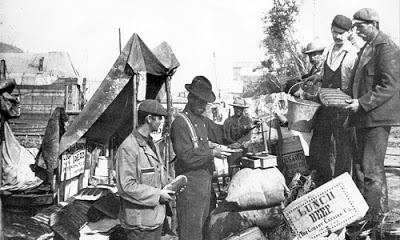
William Hiscock related that one day while walking in Dawson City he saw a man throwing silver coins out into the river. Someone had just purchased goods in his store and paid in Cheechako (silver) money. "He said nothing but would have preferred the gold dust currency so he calmly takes the money and walks out to the bank of the river and disposes of it, so that it will not come into the shop again."
Hiscock said that everybody carried their gold dust in a small buckskin bag and when a purchase was made in any of the stores, large or small, you poured the gold into a small tin scoop and then shook it in to a small set of gold scales. The amounts for convenience were dollars and cents stamped on the weights.
At the time gold dust was worth about $16 an ounce. Today gold is in the $1750-$1800 range per ounce. Seen above is a fellow paying for a loaf of bread with gold dust.
Dick adds:
Cheechako Money was also known as Steamboat or Riverboat Money - what the newcomers had in their pocket. In Yukon, the First Nations (Indians) much preferred the tokens of Taylor Drury and Pedlar (based in Whitehorse, but they had trading posts throughout the Yukon). This is evidenced by how worn, beat up and bent their aluminum tokens are.
I had not heard the story about throwing silver money away. If someone came into a saloon or store and tried to pay with cents, nickels or dimes, it is reported that they were just brushed onto the floor. Nothing smaller than a quarter. I have some gold scale weights made by J.L. Sale, a jeweler who had stores in Dawson, Grand Forks (Bonanza) and Fairbanks.
To read the complete articles, see:
cheechako
(https://www.wordnik.com/words/cheechako)
Cheechako money
(http://www.skagwaystories.org/2011/08/09/cheechako-money/)

ANTHONY PAQUET’S MEDALETS
On December 11, 2018 NGC published a very nice (and nicely illustrated) article on the medalets of Anthony Paquet. I understand it was written by Alex Masella, an attributor/grader of tokens and medals for NGC. Here's a short excerpt - be sure to read the complete article online. -Editor
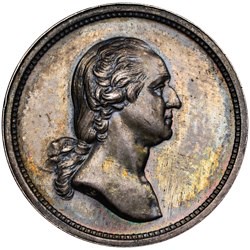
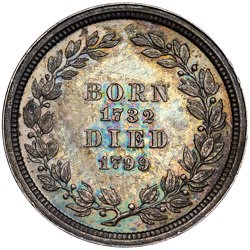
In the years leading up to the Civil War, while America was encountering political and economic problems, it was becoming a golden era for numismatics. The panic of 1857 contributed to the hoarding of large cents, but the introduction of the smaller "Flying Eagle" cent boosted interest in new coin designs. The era also witnessed the talents of many now-famous private engravers, from Joseph Merriam to George H. Lovett.
By 1858, over a dozen coin dealers and firms established themselves in the larger northern cities, like New York, Philadelphia, Boston, and Baltimore. The demand for new medals commemorating events, historical figures, and politicians was at a high point. Die sinkers were commissioned by dealers and collectors to create hundreds of "fancy pieces" to fill collectors’ cabinets. The fierce election of 1860 also saw the production of many politically themed medalets.
With the Mint Cabinet program featuring Washington rolled out by Mint Director James Ross Snowden, and culminating with the dedication ceremony in early 1860, it became clear that the Mint could also profit from the recent enthusiasm for new medals.
Beginning in 1861, the Mint started producing dime-sized silver medalets featuring George Washington and Andrew Jackson (other presidents would soon follow).
Though the medalets were first produced in silver and gold, Julian notes that in the 1870s, bronze examples were occasionally made. These "original" bronze strikes are actually more rare than their silver counterparts. Bronze strikings of most of the dies continued in the 1880s, and early restrikes were made after 1904. Restrikes continued throughout the 20th century. The restrikes have a different look and composition from originals. While originals were composed entirely of copper—with a bronzed finish—restrikes were produced in true bronze, having a composition of 90 percent copper and 10 percent zinc.
Restrikes produced as late as the 1970s are more yellow in color, and have a dull, sandblasted finish. These can still be acquired for only a few dollars, often finding their way into dealers’ "junk" bins. NGC distinguishes these late 1970s restrikes from the earlier ones by using the language "modern restrike" and simply "restrike". The modern restrikes are far more common than the originals.
To read the complete article, see:
Paquet’s Medalets Sold at the Philadelphia Mint
(https://www.ngccoin.com/news/article/7017/Paquet-Medalets/)
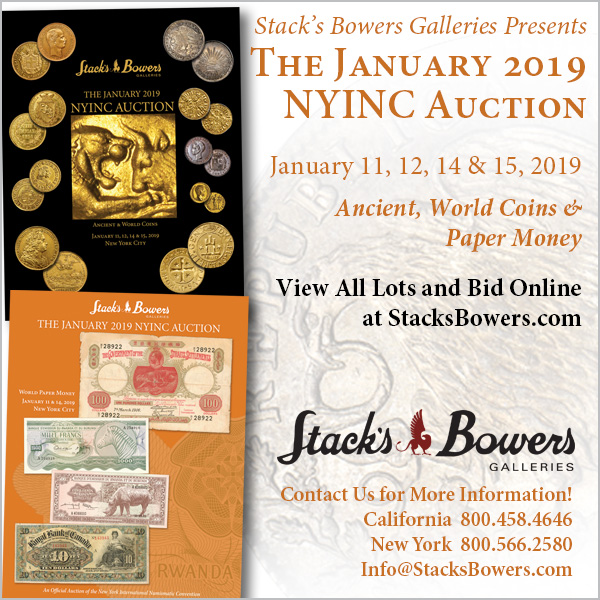
ROYAL HUMANE SOCIETY GOLD MEDAL SOLD
A beautiful lifesaving medal recently sold by Morton & Eden was featured in this January 5, 2019 article from The Courier of Dundee, Scotland. -Editor
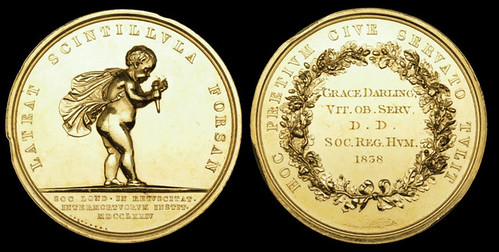
When Grace Darling helped to rescue men from the SS Forfarshire, which struck the Farne Islands in 1838 en route to Dundee, The Times newspaper gushed, ‘Is there, in the whole field of history or of fiction, even one instance of female heroism to compare for one moment with this?’
The Dundee ship’s stern was swept away, carrying the captain, his wife and the cabin passengers to their deaths. A passing ship later picked up nine men in a lifeboat. The forward half of the vessel remained jammed and 11 survivors clambered on to the rocks. Two children were to die in their mother’s arms before Grace Darling and her lighthouse-keeper father William could reach the survivors by rowing out in the rough seas.
Seven of the nine saved by the Darlings were from Dundee. An unprecedented amount of publicity followed. Medals and money were gifted to her and artists queued to paint her. Tragedy followed tragedy. Grace Darling died of tuberculosis in 1842, just four years after the rescue. She was only 25.
Morton & Eden auctions in London have just sold the Royal Humane Society gold medal and other awards, including one from the people of Arbroath, presented to the young heroine.
The medal marked two historic firsts: it was the first Royal Humane Society gold award to a civilian for life-saving at sea, and the first official British gallantry medal awarded to a female recipient.
Included in the lot was a gold presentation locket with engraved inscription, ‘To Miss Grace H. Darling, from a few Gentlemen of Arbroath, to mark their sense of her brave conduct on the 7th September, 1838.’
This rare and historically significant group took £32,000.
To read the complete article, see:
Darlings’ bravery commemorated in rare medal
(https://www.thecourier.co.uk/fp/lifestyle/house-home/collectors-corner/777342/darlings-bravery-commemorated-in-rare-medal/)
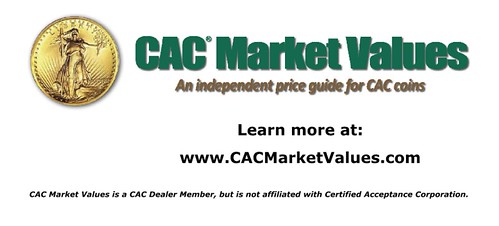
500-EURO BANKNOTES: THE LAST PRINT RUNS
In a story that's been developing over several years, most Euro zone nations have stopped printing their largest denomination banknote, the 500 Euro. -Editor
 The eurozone is moving to stop printing 500-euro banknotes, the violet-coloured bills that authorities fear are favoured by criminals, with most of the 19 nations in the currency bloc to halt issuing them next month.
The eurozone is moving to stop printing 500-euro banknotes, the violet-coloured bills that authorities fear are favoured by criminals, with most of the 19 nations in the currency bloc to halt issuing them next month.
"As of 27 January 2019, 17 of the 19 national central banks in the euro area will no longer issue 500-euro banknotes," the European Central Bank said on its website.
However, Austria and Germany will both continue printing the banknotes until April 26 "in order to ensure a smooth transition and for logistical reasons", the ECB said.
The 500-euro notes in circulation remain legal tender and can be used to make payments.
The ECB announced in May 2016 that it would halt issuing new 500-euro notes, saying at the time that it expected to do so around the end of 2018, due to "concerns that this banknote could facilitate illicit activities".
The largest denomination banknote in the single currency area is one of the world's most valuable bills, alongside the 1,000 Swiss franc ($1,017, 888 euros) note.
Because of its high value and portability, experts believe the 500-euro note had become prized by criminals for money laundering and even terrorist financing, earning the nickname "Bin Laden" in some circles.
To read the complete article, see:
500-euro note gets last print run
(https://www.france24.com/en/20181231-500-euro-note-gets-last-print-run)
To read earlier E-Sylum articles, see:
ORGANIZED CRIME AND THE 500 EURO BANKNOTE
(https://www.coinbooks.org/esylum_v13n31a22.html)
THE 500 EURO ‘BIN LADEN’ BANKNOTE
(https://www.coinbooks.org/esylum_v16n15a26.html)
EUROPE TO DISCONTINUE 500-EURO BILL
(https://www.coinbooks.org/esylum_v19n19a29.html)
BLACK MARKET PRICE OF €500 NOTE COULD RISE
(https://www.coinbooks.org/esylum_v19n20a29.html)
THE BOND THAT STILL PAYS, 280 YEARS LATER
A French government bond researched by E-Sylum contributor François Velde is featured in a Wall Street Journal article this weekend. -Editor
The French government has owed Marie Verrier’s family money for a long time. Almost 300 years.
All Ms. Verrier and her husband, Jean, have to do to claim the world’s oldest government debt is prove they are the descendants of an obscure 18th-century lawyer.
The question is whether it’s worth the effort: Three centuries of inflation and shifting currencies mean this debt yields just €1.20 a year, the modern-day equivalent of the long-defunct livres the bond was issued in.
"That [yield] would allow you to buy a baguette of bread once a year," said the 81-year-old Mr. Verrier from the couple’s home in the Parisian suburb of Asnières-sur-Seine.
Bonds that never mature, or do so after a century or longer, aren’t just museum pieces. The ultralow interest rates of the last decade have encouraged governments and corporations to borrow for increasingly long periods, with some even selling 100-year bonds now.
In some cases, long bonds have become collectors’ items worth more than the would-be payout. Dealers in such bond certificates say that prices collectors pay for ultralong bond certificates could go for up to $5,000, depending on their age, rarity and historic importance.
Bob Kerstein, founder of dealership Scripophily.com, said he recently sold for about $700 a New Jersey Junction Railroad company bond from 1886 which was signed by the financier J.P. Morgan. Scripophily is the name of the hobby that includes old bond and stock certificates.
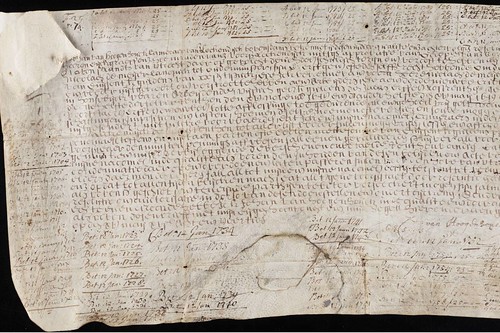
World's oldest bond still paying interest
In 2003, Yale University acquired the world’s oldest debt still being honored: a 1648 corporate Dutch water authority bond written on goatskin. "Such bonds are like a postcard from a different time," said Geert Rouwenhorst, professor of corporate finance at Yale, who as part of a scholarly endeavor collected the payment, which runs at €11.35 a year, from the Dutch water board several years ago.
Because it was a bearer bond, where the debt is owed to whoever carries it, Mr. Rouwenhorst had to fly to Amsterdam and hold the strip of goatskin to receive the interest, collecting 26 years of back payments while there.
The Verriers don’t physically own the 280-year-old bond known as the "Linotte rente," named after Claude-Henri Linotte, a 18th-century lawyer. Rather, they have a chest stuffed with letters and documents showing how their family descends from Linotte—and why they could potentially lay claim to the world’s oldest government debt.
The Linotte rente has endured five French republics, two world wars and persistent, if unsuccessful, attempts by the French government to get rid of it. An economist at the Federal Reserve Bank of Chicago, François Velde, unearthed the debt during research in Paris in the 1990s and alerted the Verriers.
To read the complete article (subscription required), see:
The Bond That’s Still Paying Interest, 280 Years Later
(https://www.wsj.com/articles/the-bond-thats-still-paying-interest-280-years-later-11546603201)

LOOSE CHANGE: JANUARY 6, 2019
Here are some additional items I came across in the media this week that may be of interest. -Editor
The $3 Million $1,000 Bill
Martin Kaplan passed along this Bloomberg article about the 1891 Marcy $1,000 bill from the Joel R. Anderson collection. Thanks. -Editor
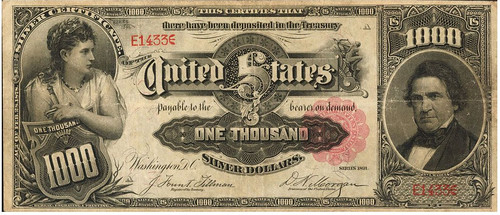
One of those $1,000 bills ended up in the Smithsonian. Another remained in a private collection for over 80 years; its first reported sale as a collectible item, rather than a piece of currency, was in the 1970s. The rest, presumably, were lost. ("I’d bet a lot of money that another one of these notes won’t turn up," Treglia says. "Things are discovered all the time, but not of this magnitude.")
That single remaining note, dubbed the "Marcy Note" because it features a portrait of U.S. Senator (also secretary of war and governor of New York) William Marcy, is now up for auction with an estimate of $2 million to $3 million.
To read the complete article, see:
The $1,000 Bill That Could Be Worth $3 Million
(https://www.bloomberg.com/news/articles/2018-12-20/the-1-000-bill-that-could-be-worth-3-million)
The Infamous Spencer M. Clark Portrait
Atlas Obscura published a nicely done piece on the Fractional Currency note with the image of National Currency Bureau Superintendent Spencer M. Clark. -Editor
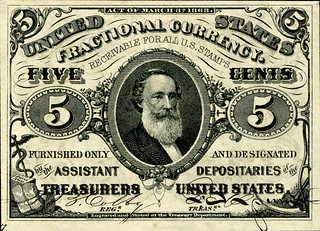 In 1866, Spencer M. Clark, then Superintendent of the National Currency Bureau, made a daring decision: to print his own face on U.S. currency.
In 1866, Spencer M. Clark, then Superintendent of the National Currency Bureau, made a daring decision: to print his own face on U.S. currency.
Clark, who served as Superintendent from 1862 to 1868, had no authorization from his superiors to do this. But U.S. paper bills were in flux because of the recent introduction of fractional money, and as the supervisor of the new bills, he was in a unique position to influence the design.
It was the third issue of that five-cent note that caught Clark’s attention. Congress had asked for the note to honor William Clark of the Lewis and Clark explorations. But allegedly, the document that reached the Treasury specified only that the new bill should honor "Clark," without clarifying which one—and Spencer M. Clark, despite surely knowing Congress's true intention, seized the opportunity to print his own face on the bill.
To read the complete article, see:
A Treasury Official in 1866 Put His Own Face on U.S. Currency
(https://www.atlasobscura.com/articles/treasury-official-us-bill-fractional-money-spencer-m-clark.amp)
Article Highlights CCAC Member Robin Salmon
Robin Salmon is following in some pretty big footsteps.
Although Salmon, the vice president of collections and curator of sculpture at Brookgreen Gardens, represents a different constituency, she was appointed to the U.S. Mint's Citizens Coinage Advisory Committee just after NBA legend Kareem Abdul-Jabbar resigned from the 11-member body.
In October, Salmon officially replaced Heidi Wastweet as the committee member specially qualified in medallic art and sculpture.
To read the complete article, see:
Brookgreen Gardens curator Robin Salmon joins U.S. Mint's commemorative coin committee
(https://www.southstrandnews.com/news/brookgreen-gardens-curator-robin-salmon-joins-u-s-mint-s/article_aea57dec-0c5e-11e9-869e-47e0704b10f0.html)
Without Hard Cash, What’s Left To Steal?
Another Wall Street Journal article this weekend imagines the cashless future. -Editor
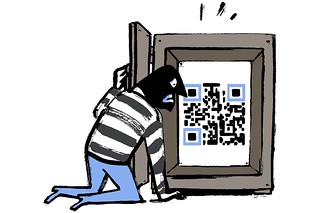 The trashing of cash is neither mean nor frivolous, nor are merchants adopting this policy because hard currency is increasingly viewed as uncool. By and large, retailers are giving the thumb's-down to the long green because employees will no longer have to waste time with coin-counting customers, or beg the manager to bring them a bunch of singles, or make runs to the bank to fetch cash. Nobody has to wrap a pile of filthy, microbe-drenched pennies at the end of their shift, hold bills up to the light to look for counterfeits, or even balance out the cash drawer.
The trashing of cash is neither mean nor frivolous, nor are merchants adopting this policy because hard currency is increasingly viewed as uncool. By and large, retailers are giving the thumb's-down to the long green because employees will no longer have to waste time with coin-counting customers, or beg the manager to bring them a bunch of singles, or make runs to the bank to fetch cash. Nobody has to wrap a pile of filthy, microbe-drenched pennies at the end of their shift, hold bills up to the light to look for counterfeits, or even balance out the cash drawer.
In theory, there is nothing wrong with sending cash, an anachronistic entity, entirely to the sidelines. If criminals insist on pulling off old-school stick-em-ups, they're going to have to make do with stealing Slim Jims, Twinkies and Dos Equis. The 7-Eleven won't have any loot to stuff inside a pillowcase.
But inevitably the Law of Unintended Effects will rear its ugly head.
To read the complete article (subscription required), see:
In a World Without Hard Cash, What’s Left To Steal?
(https://www.wsj.com/articles/in-a-world-without-hard-cash-whats-left-to-steal-11546616752)

